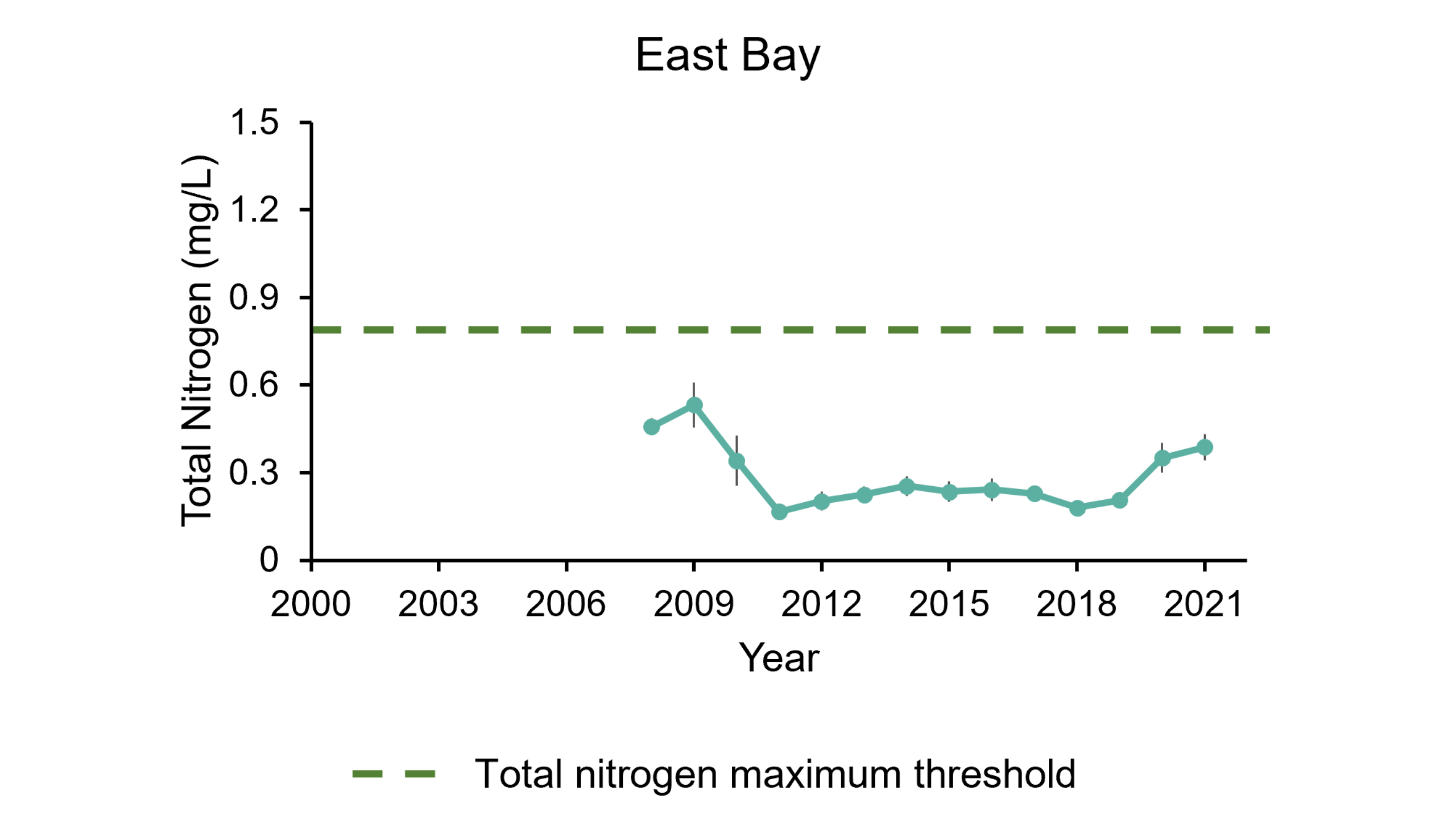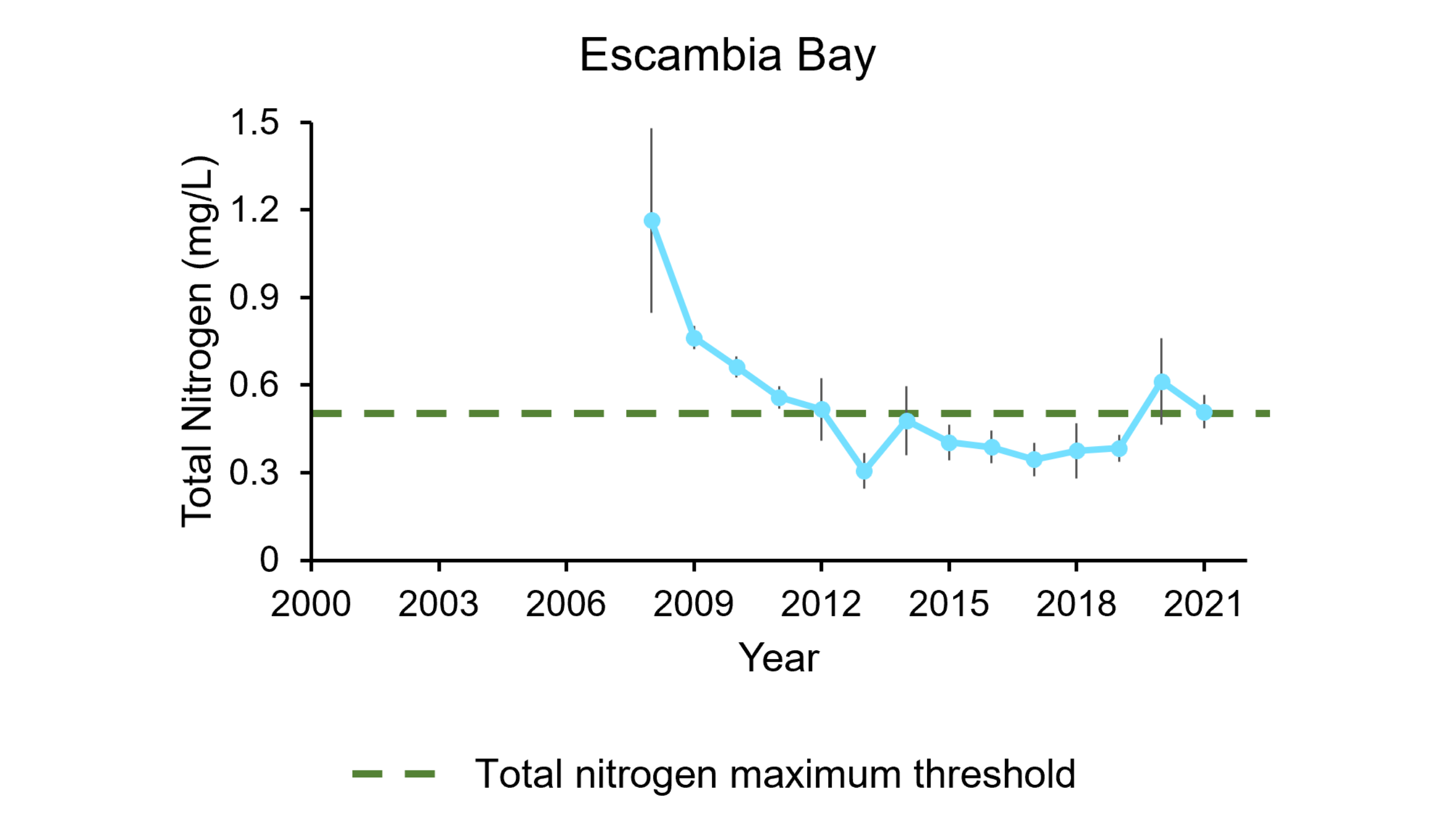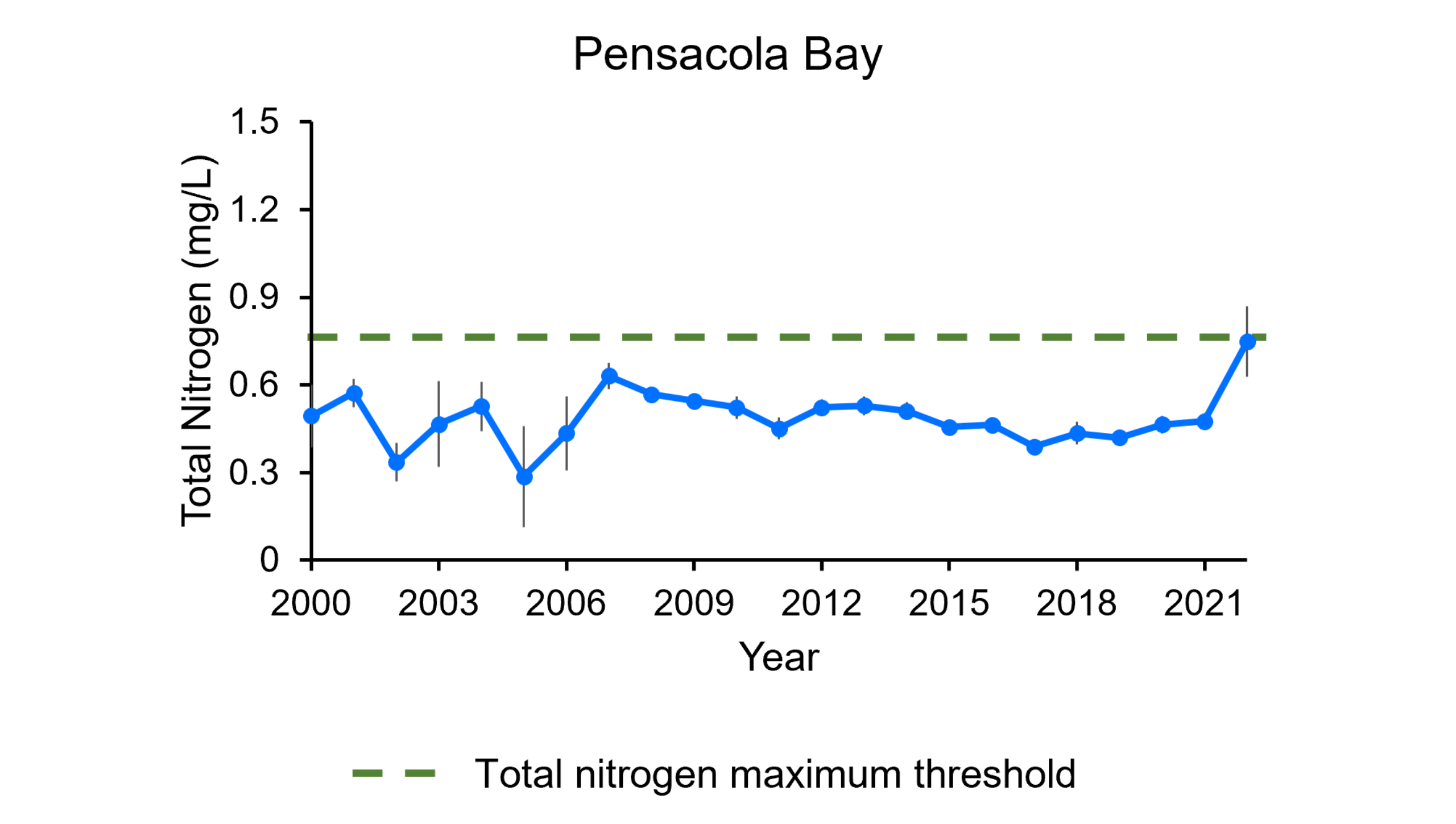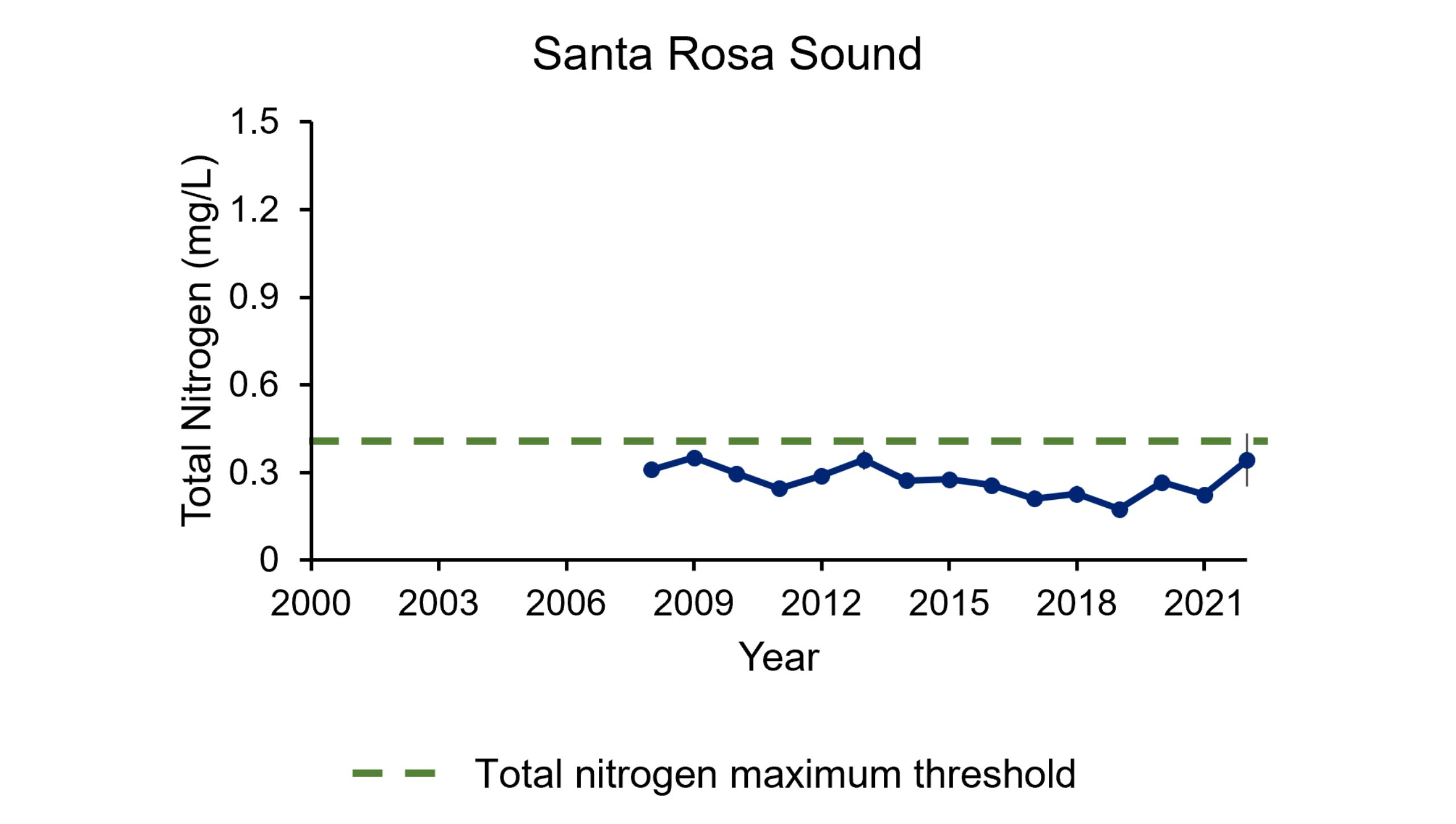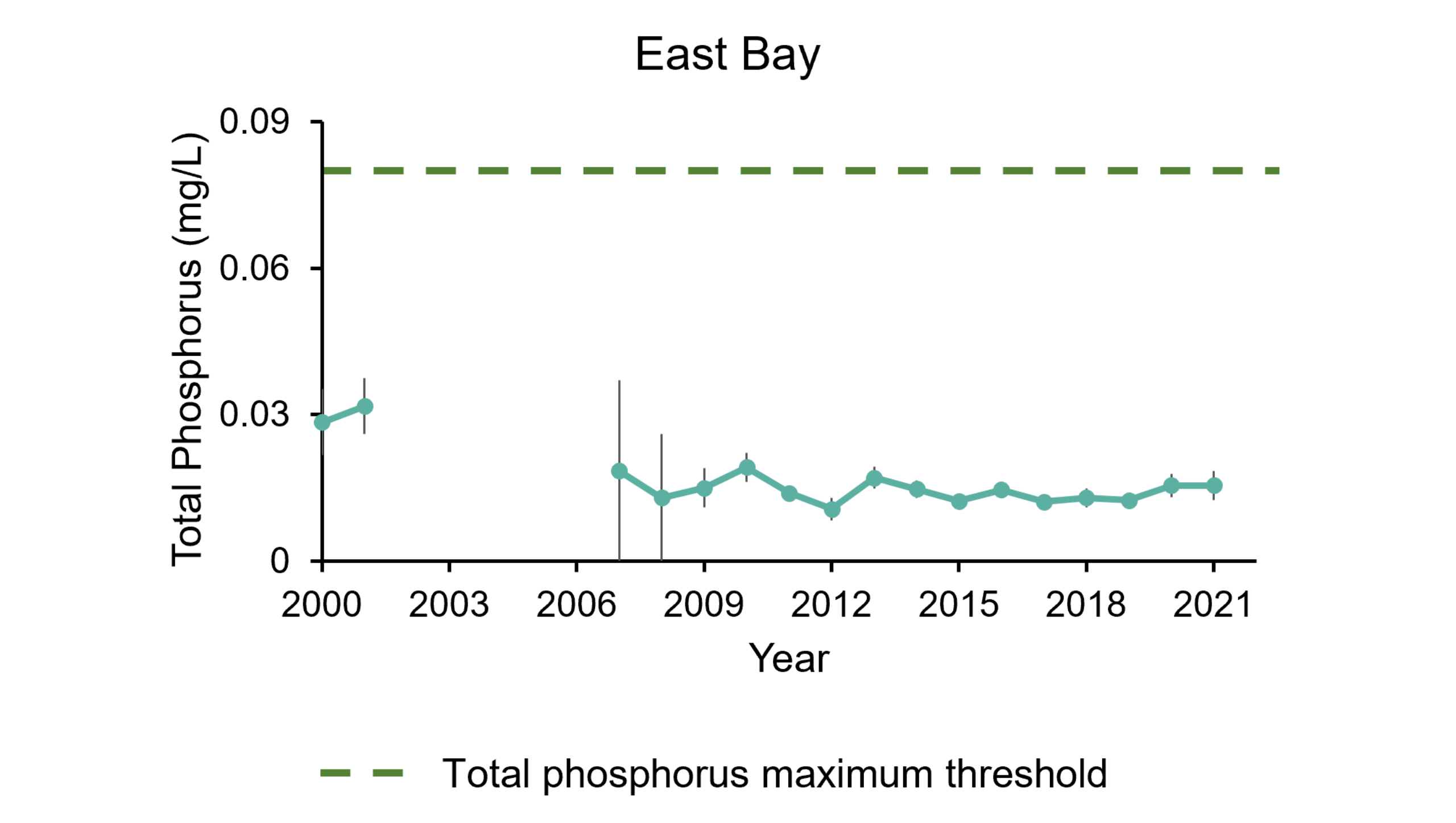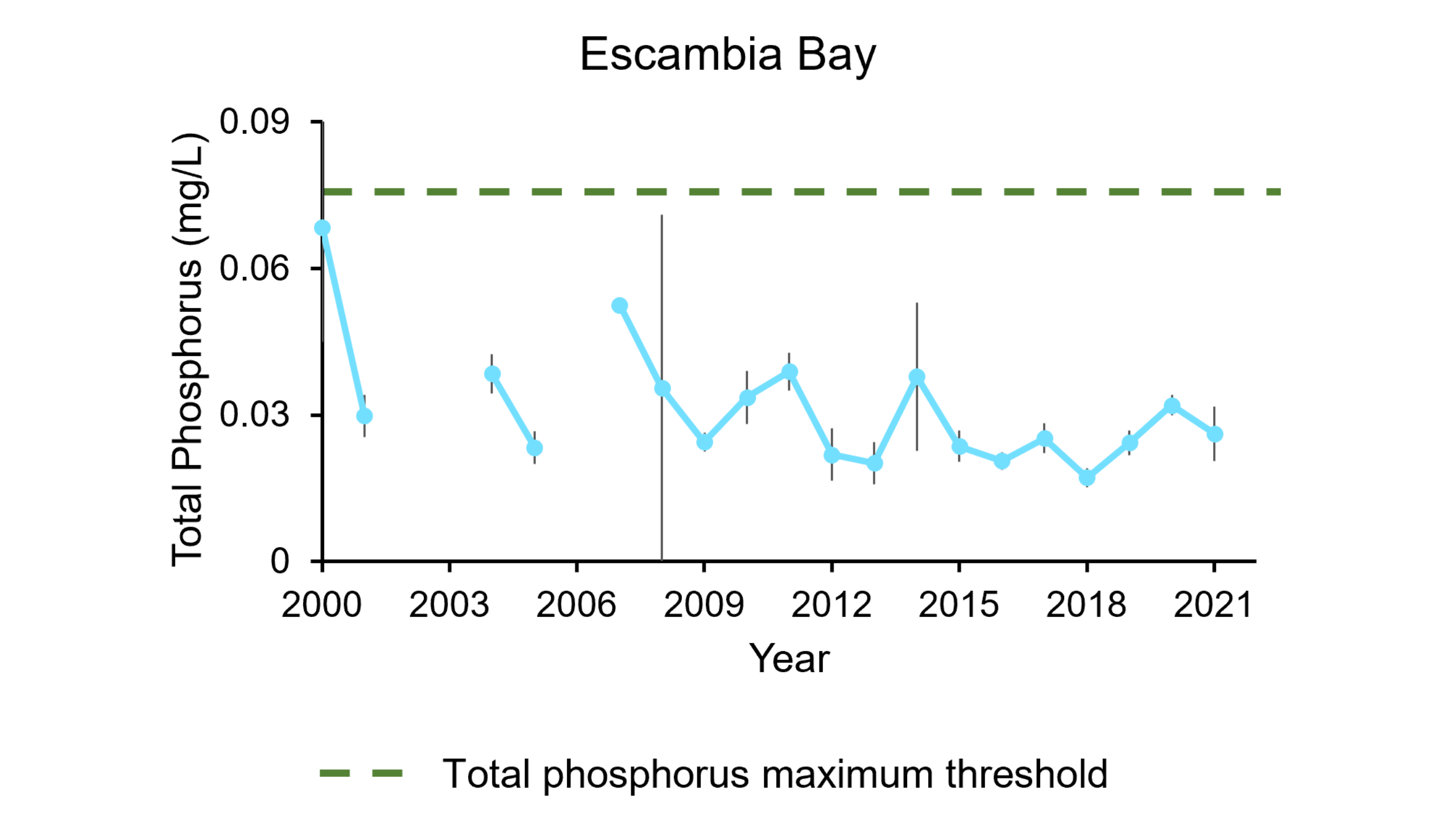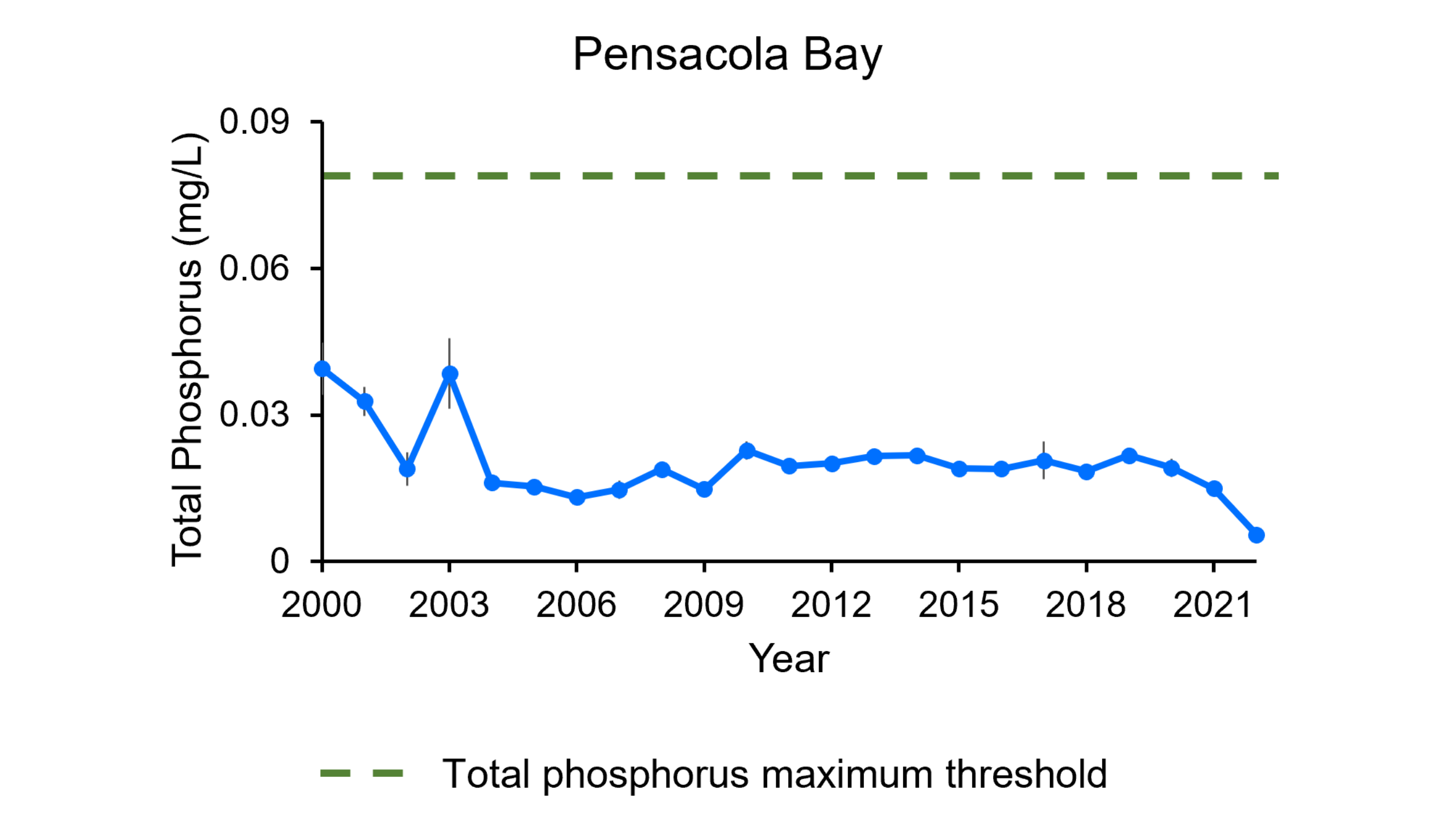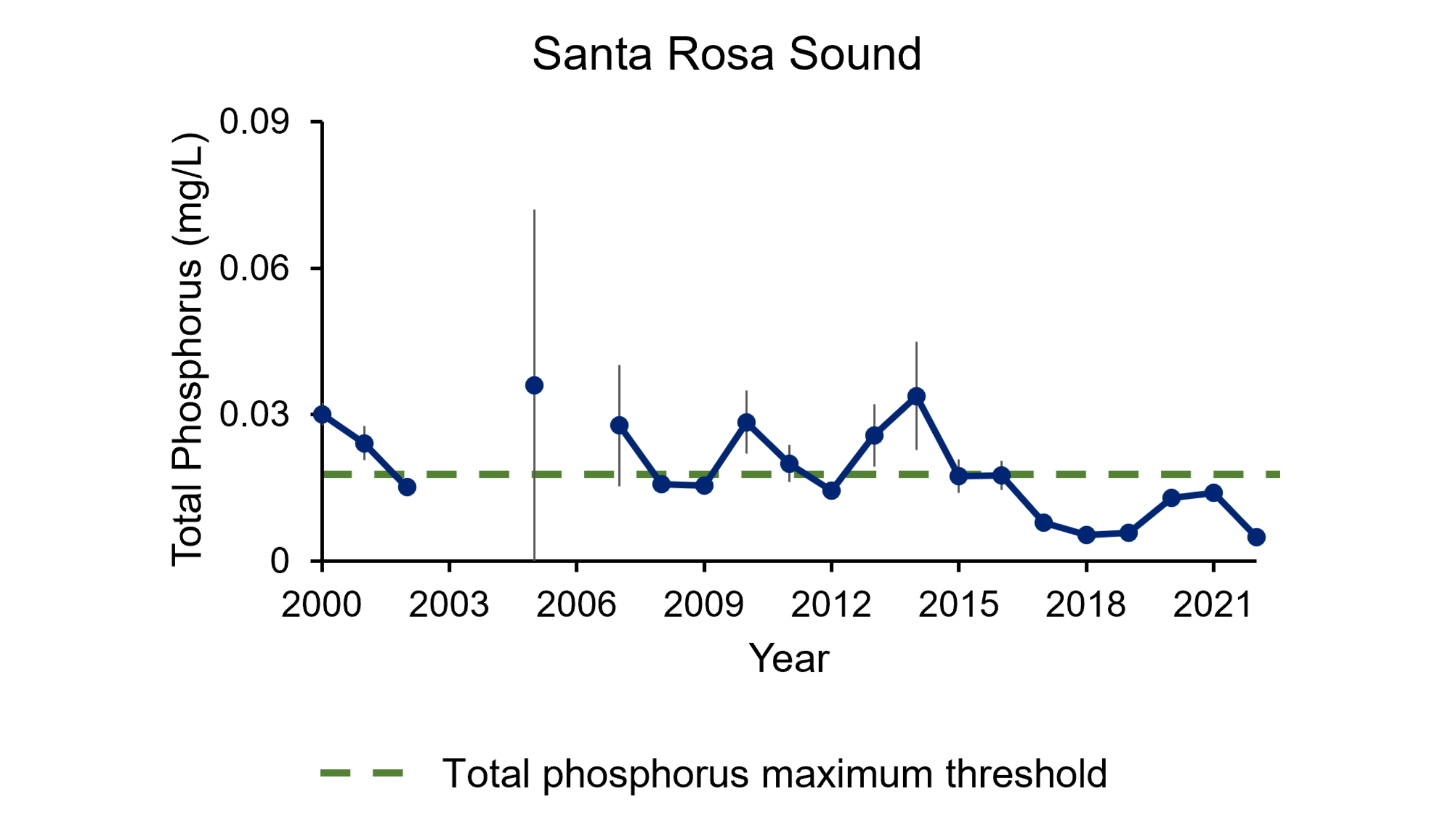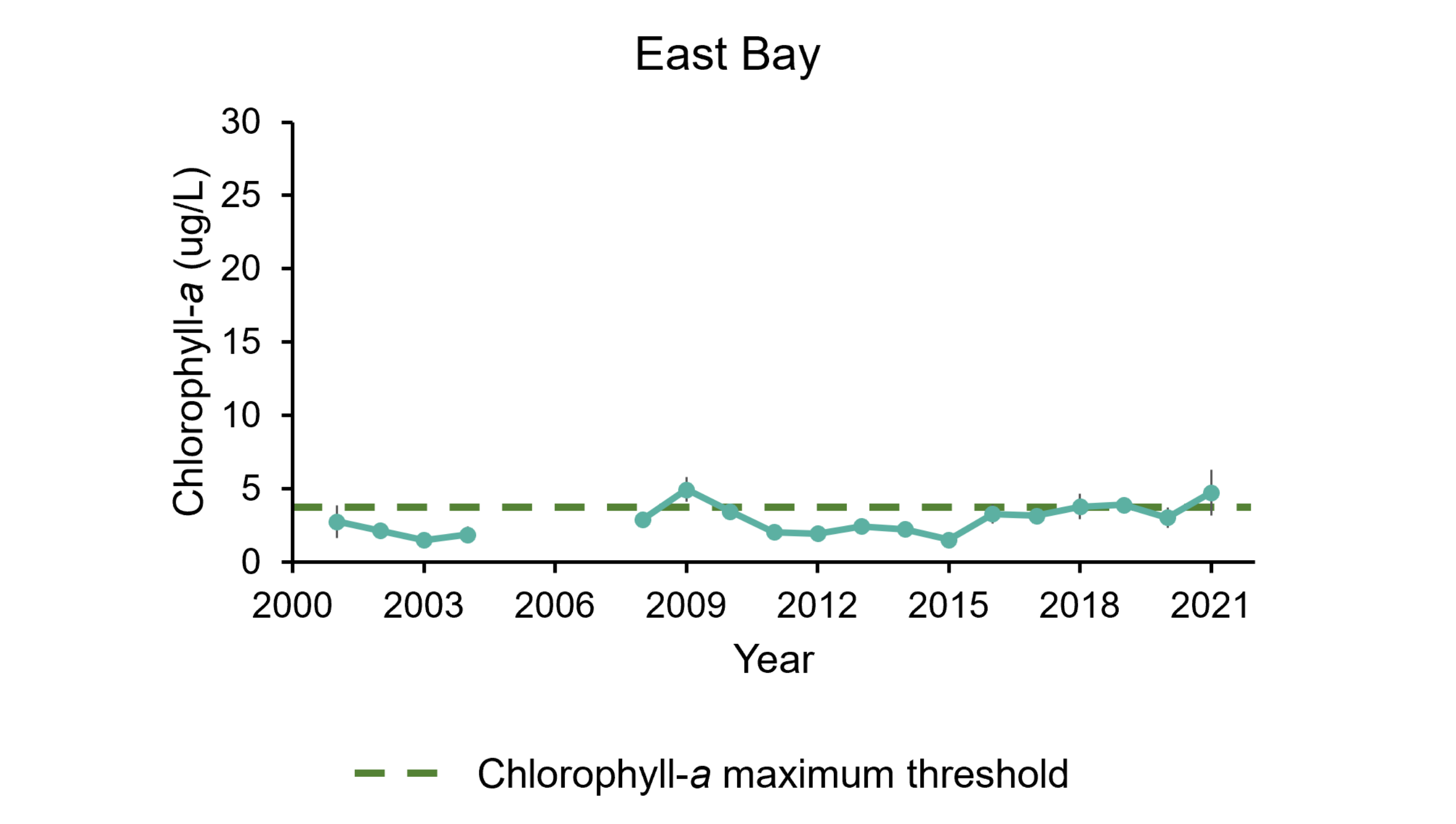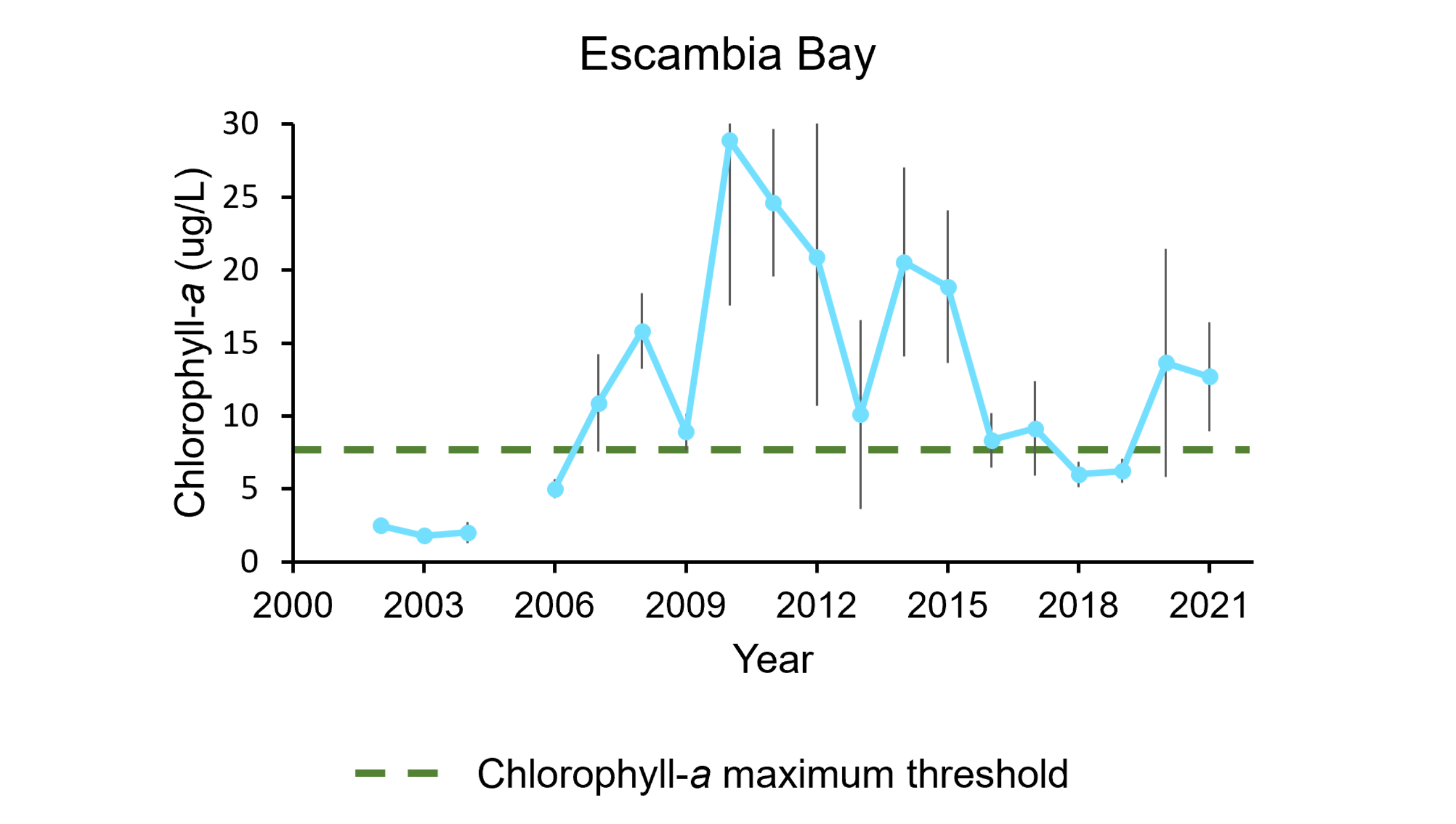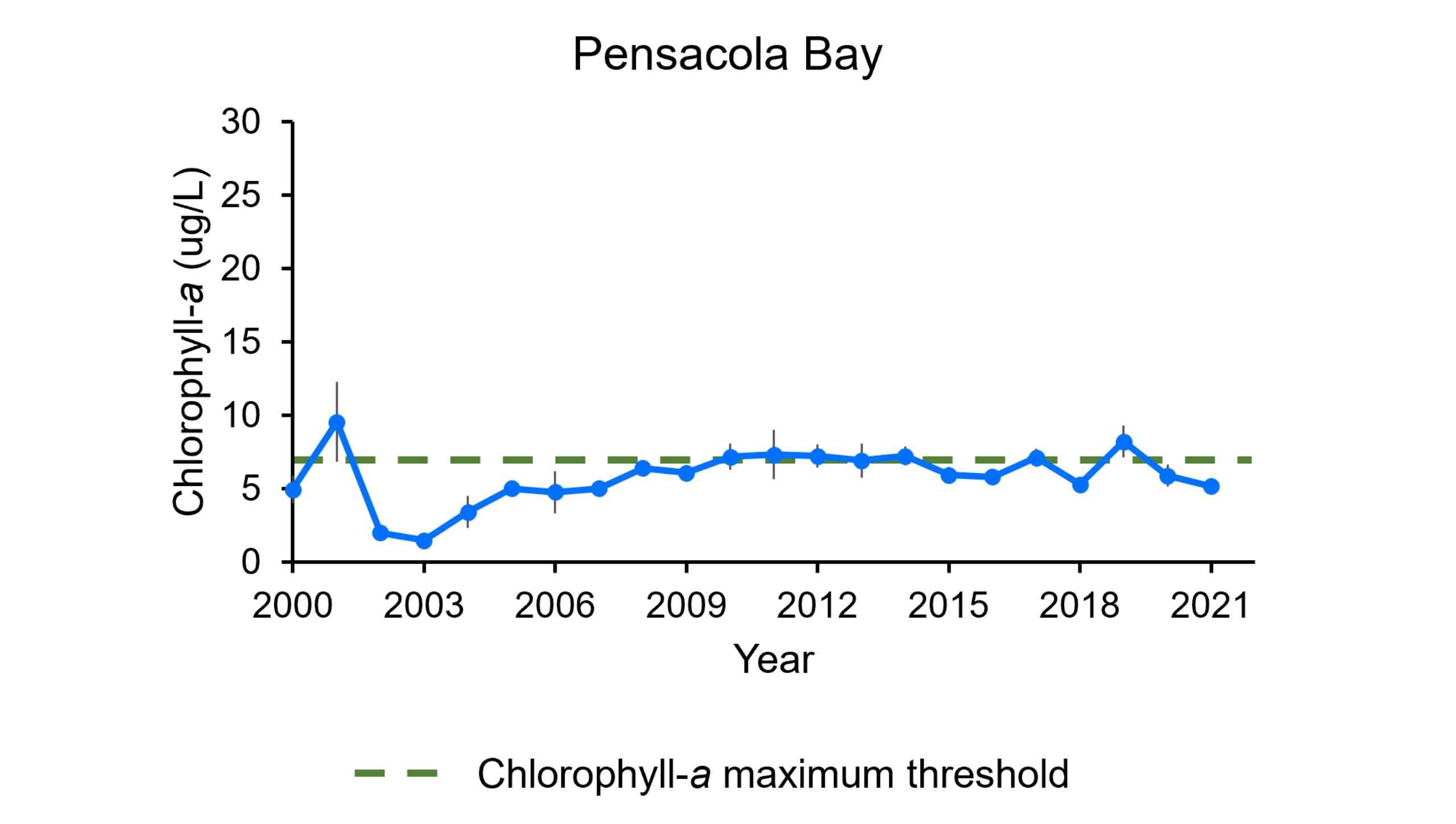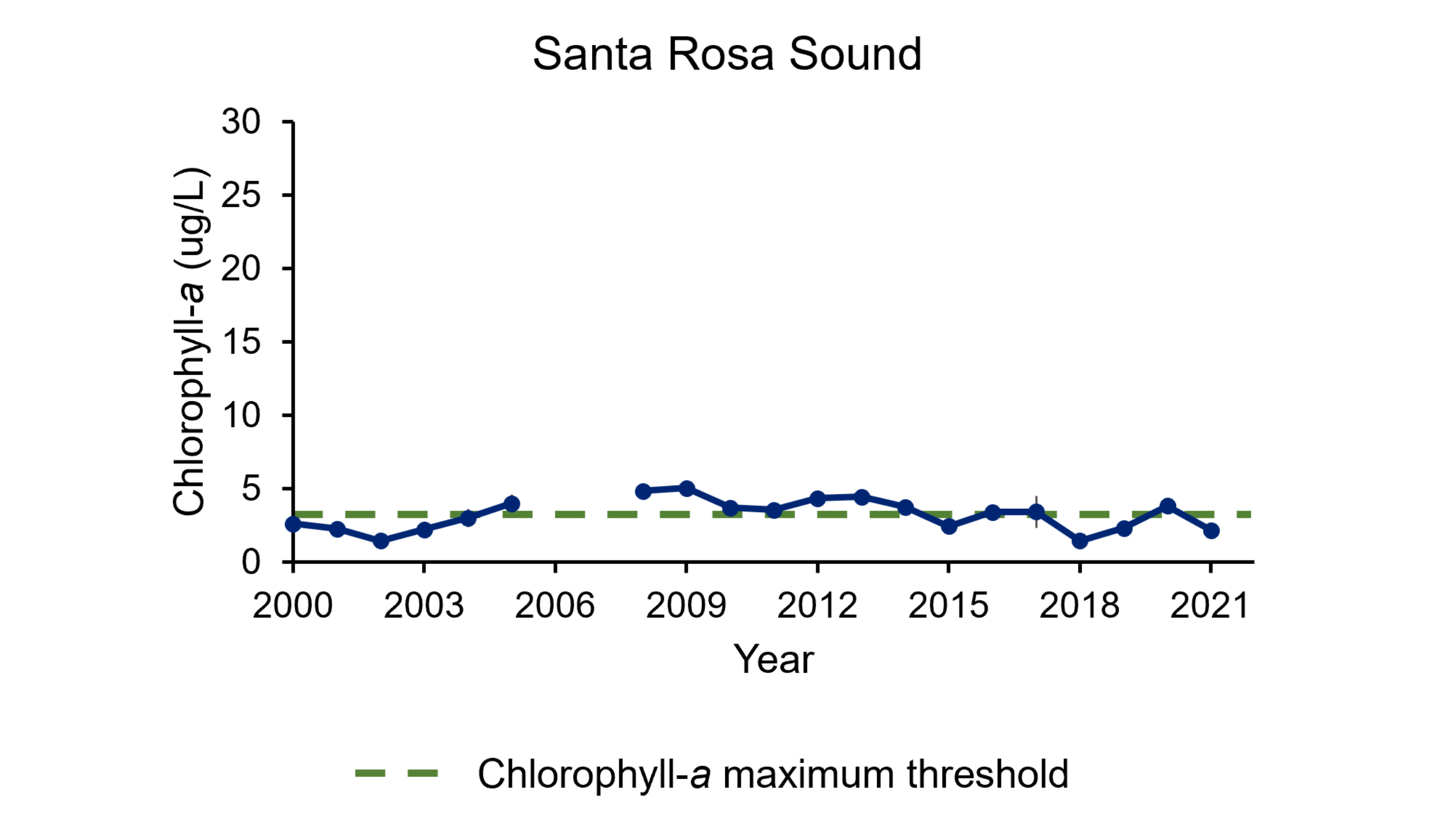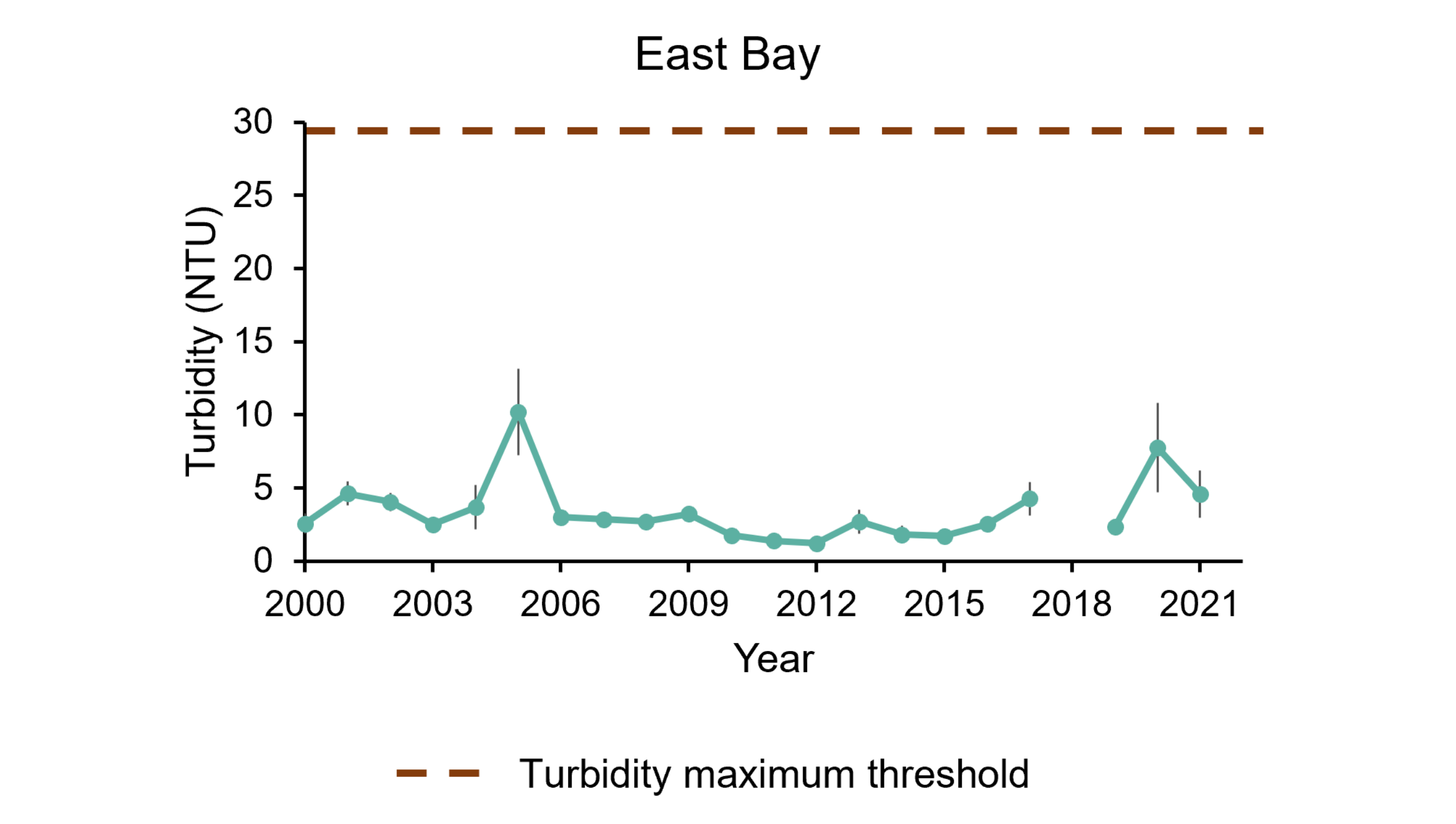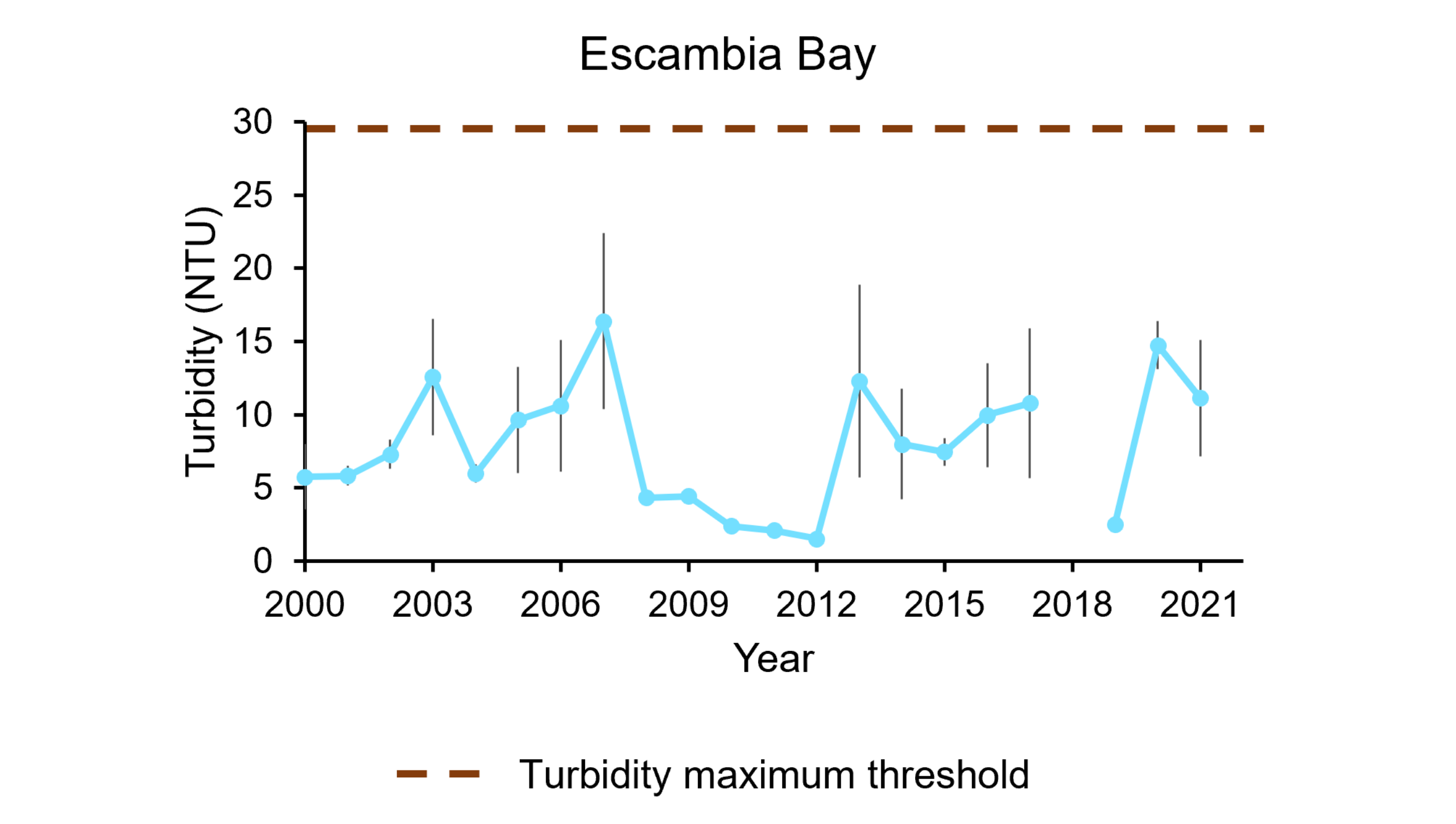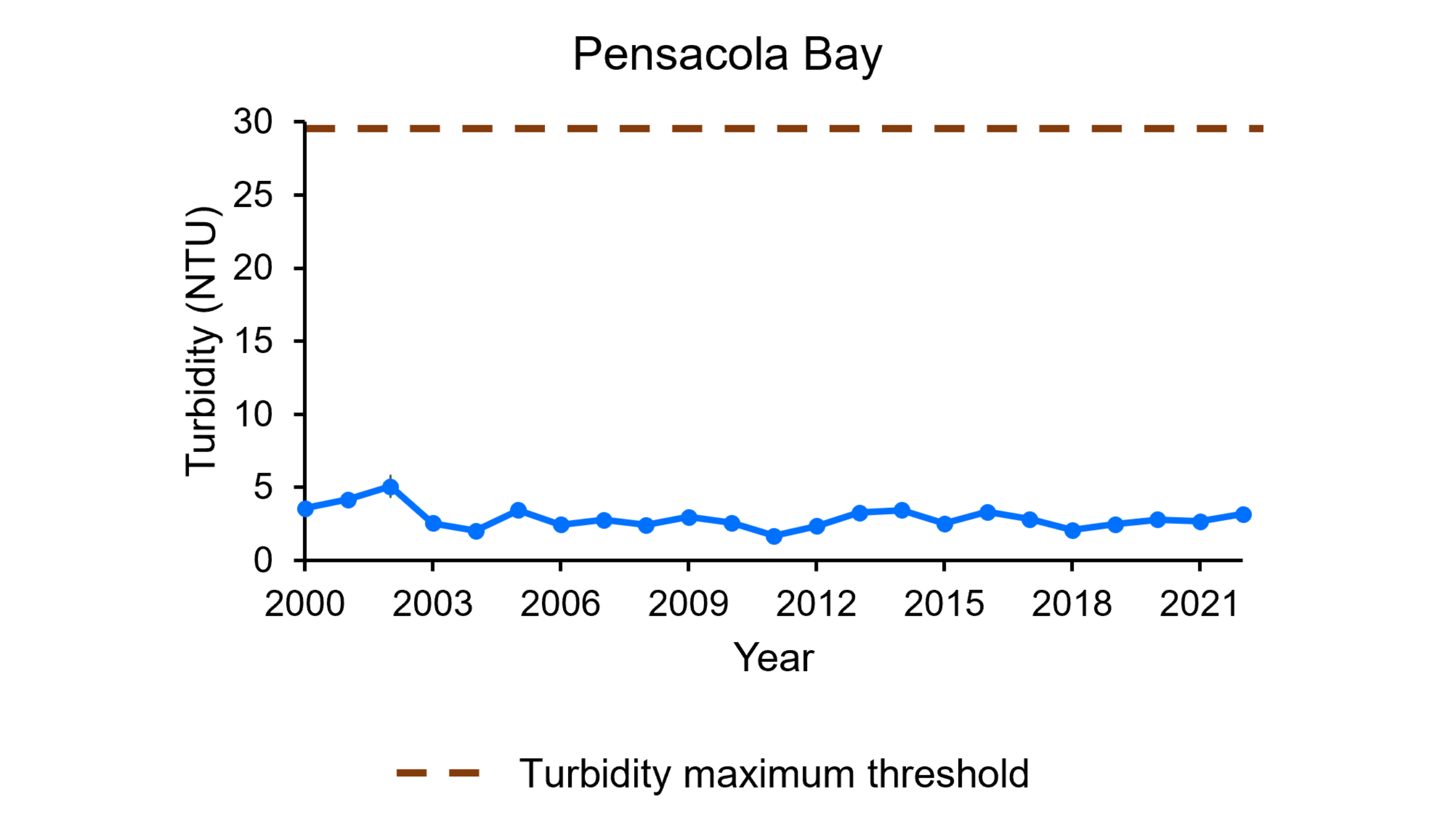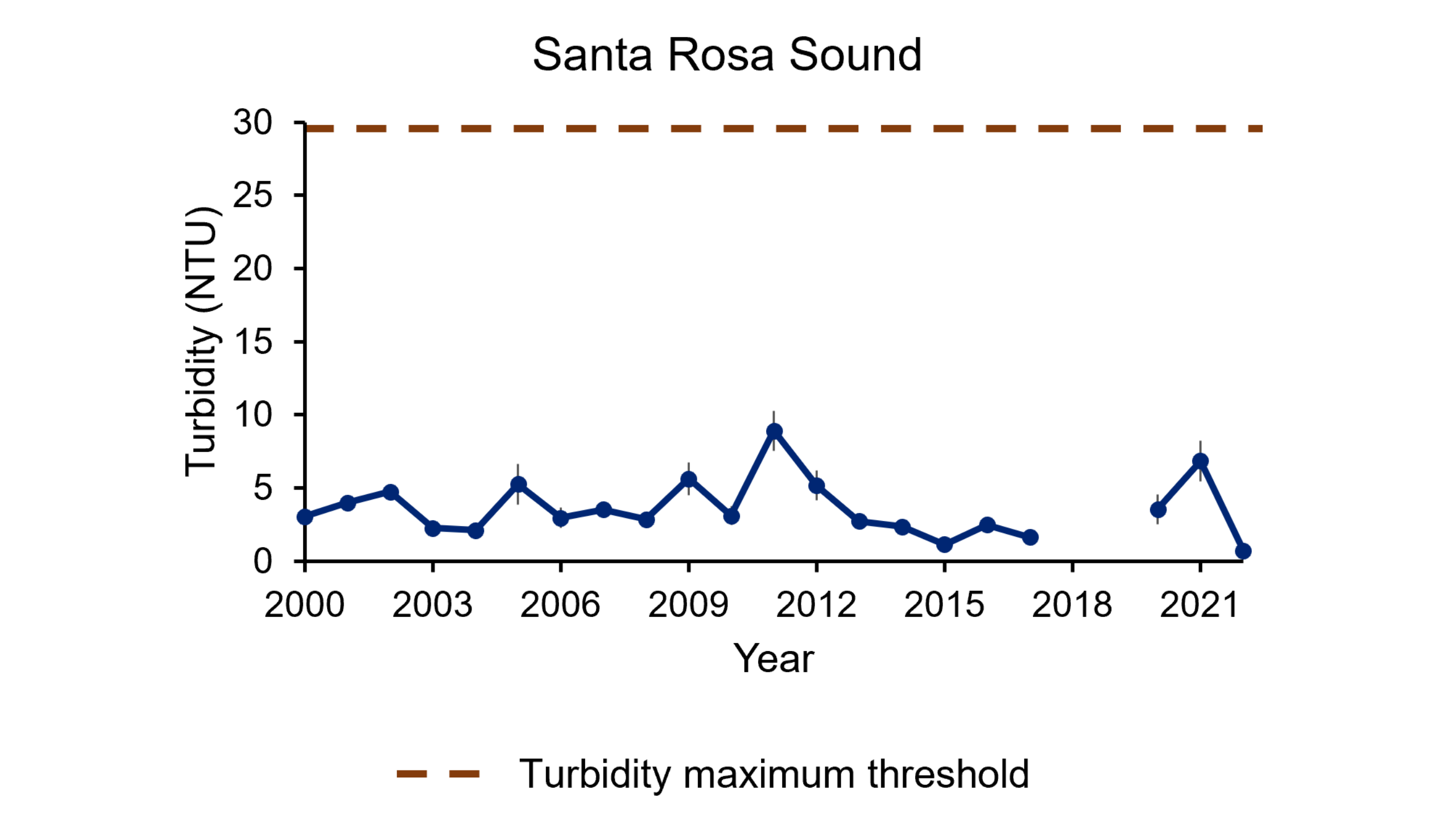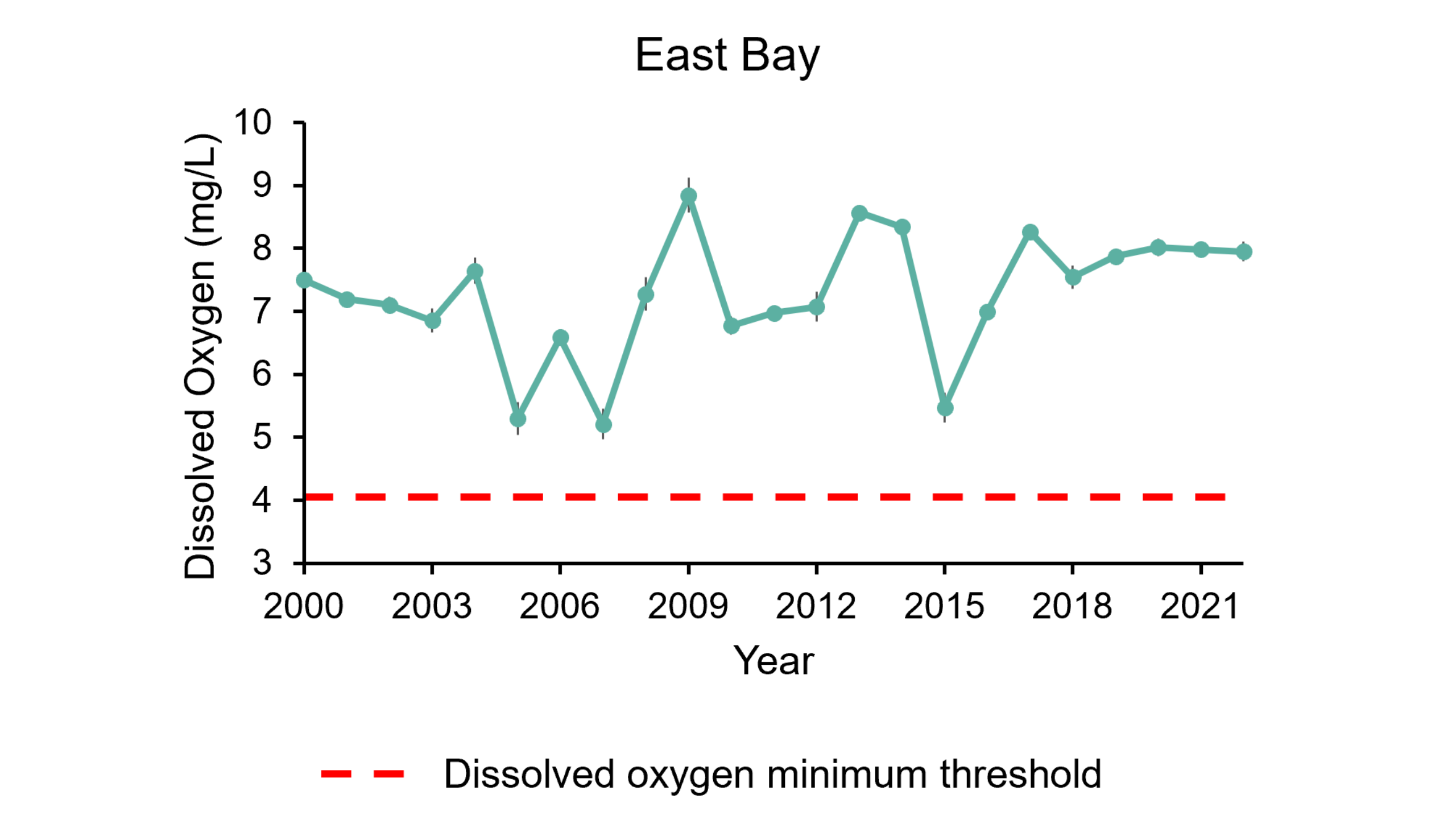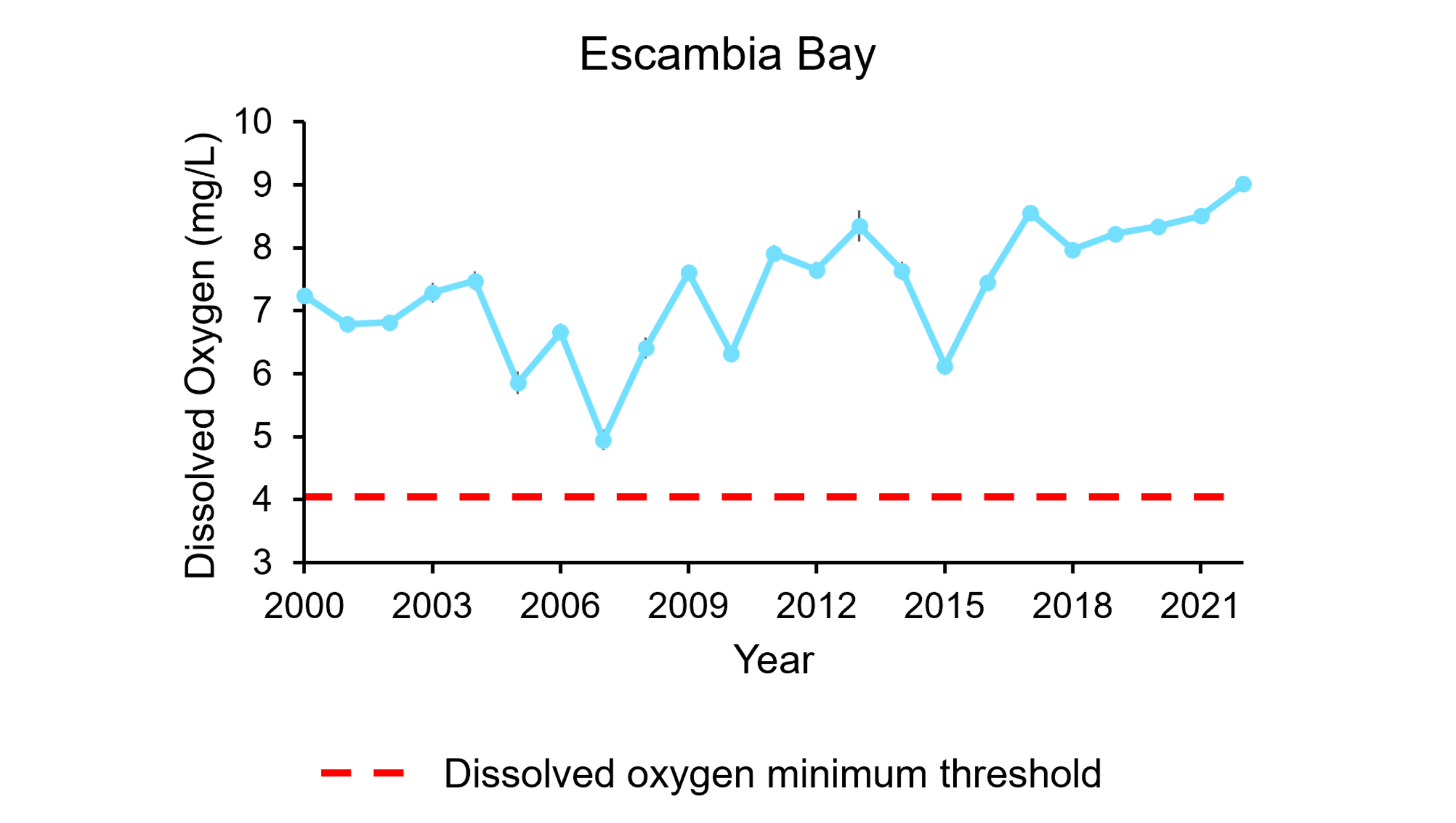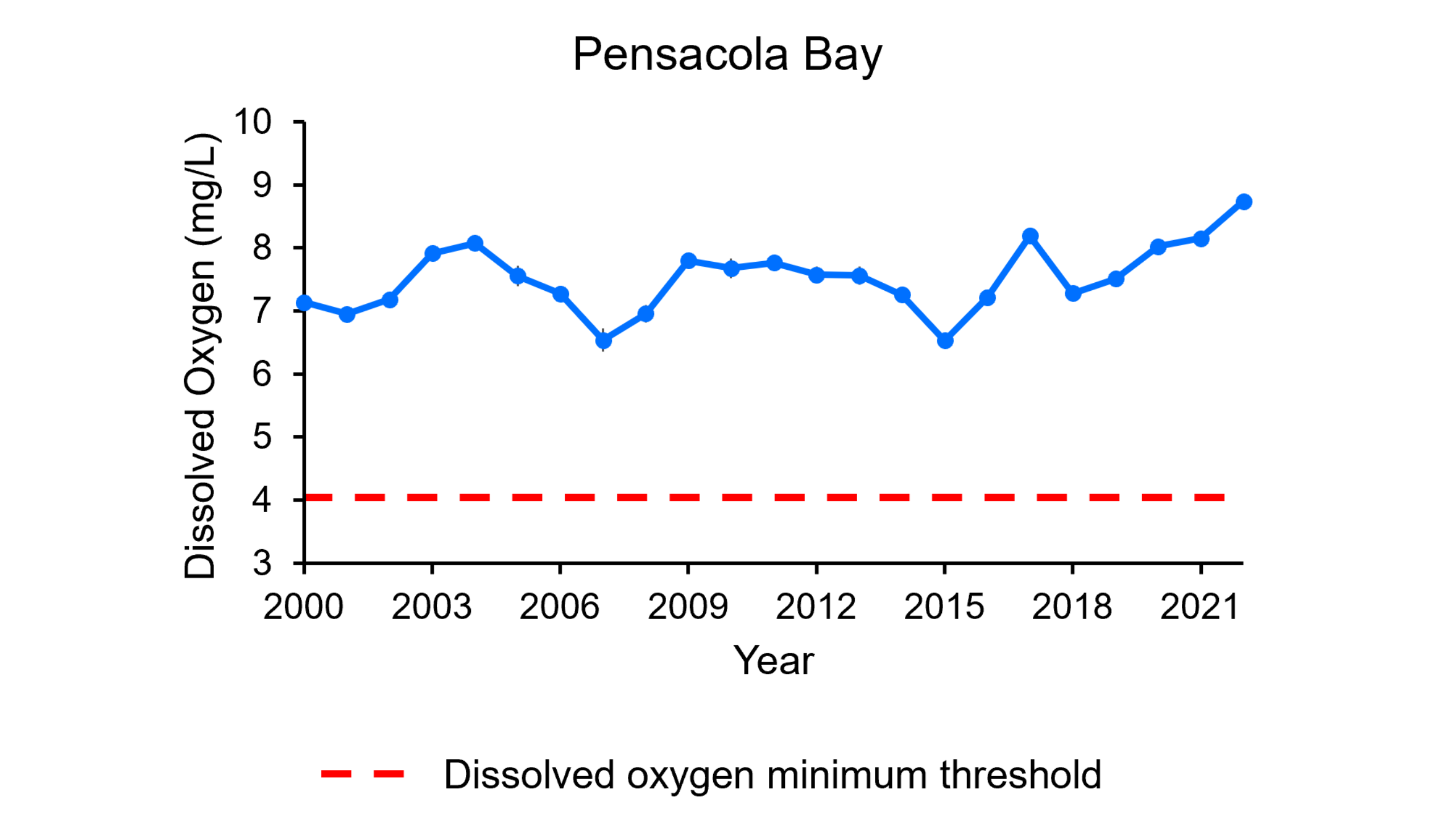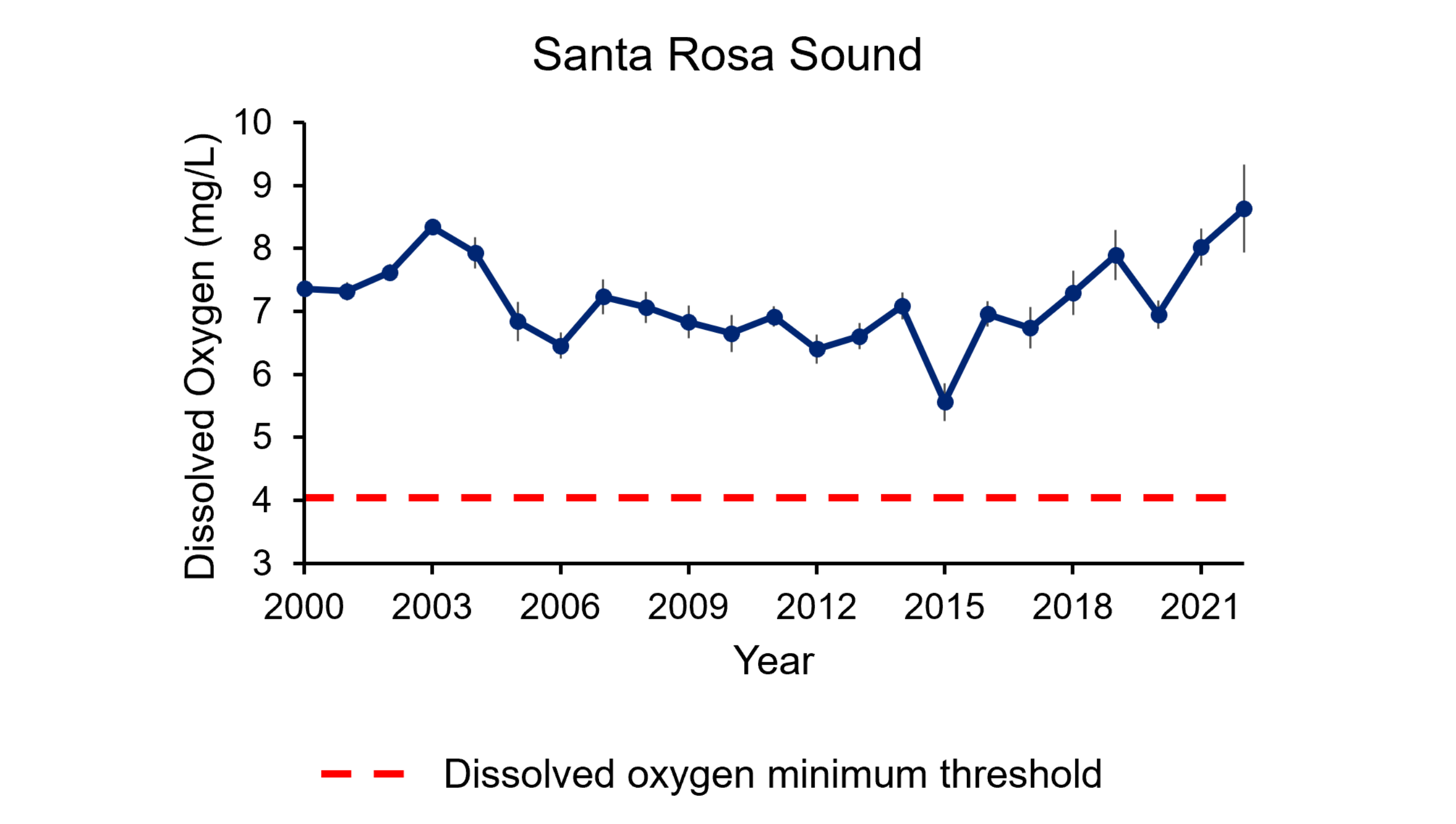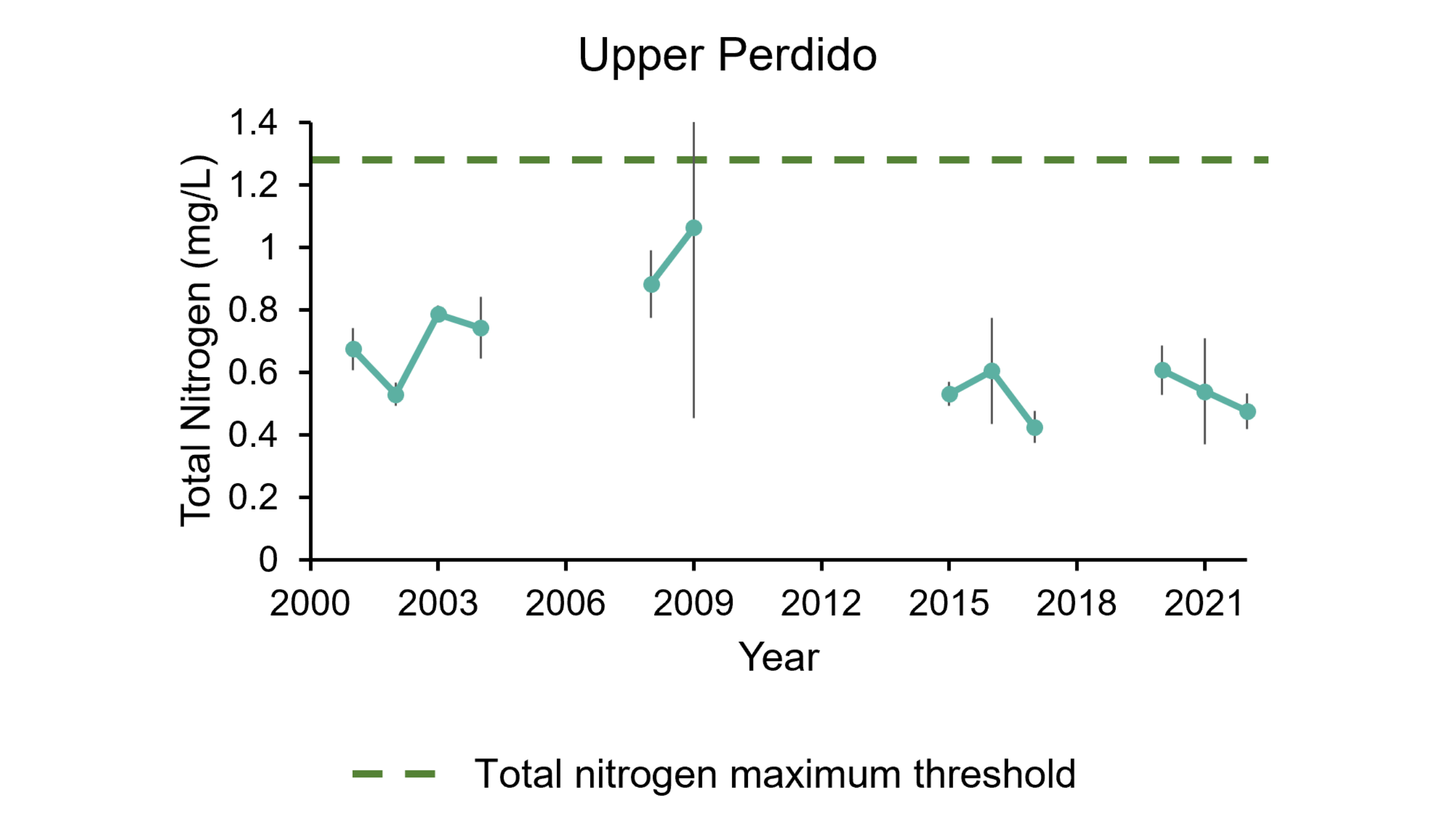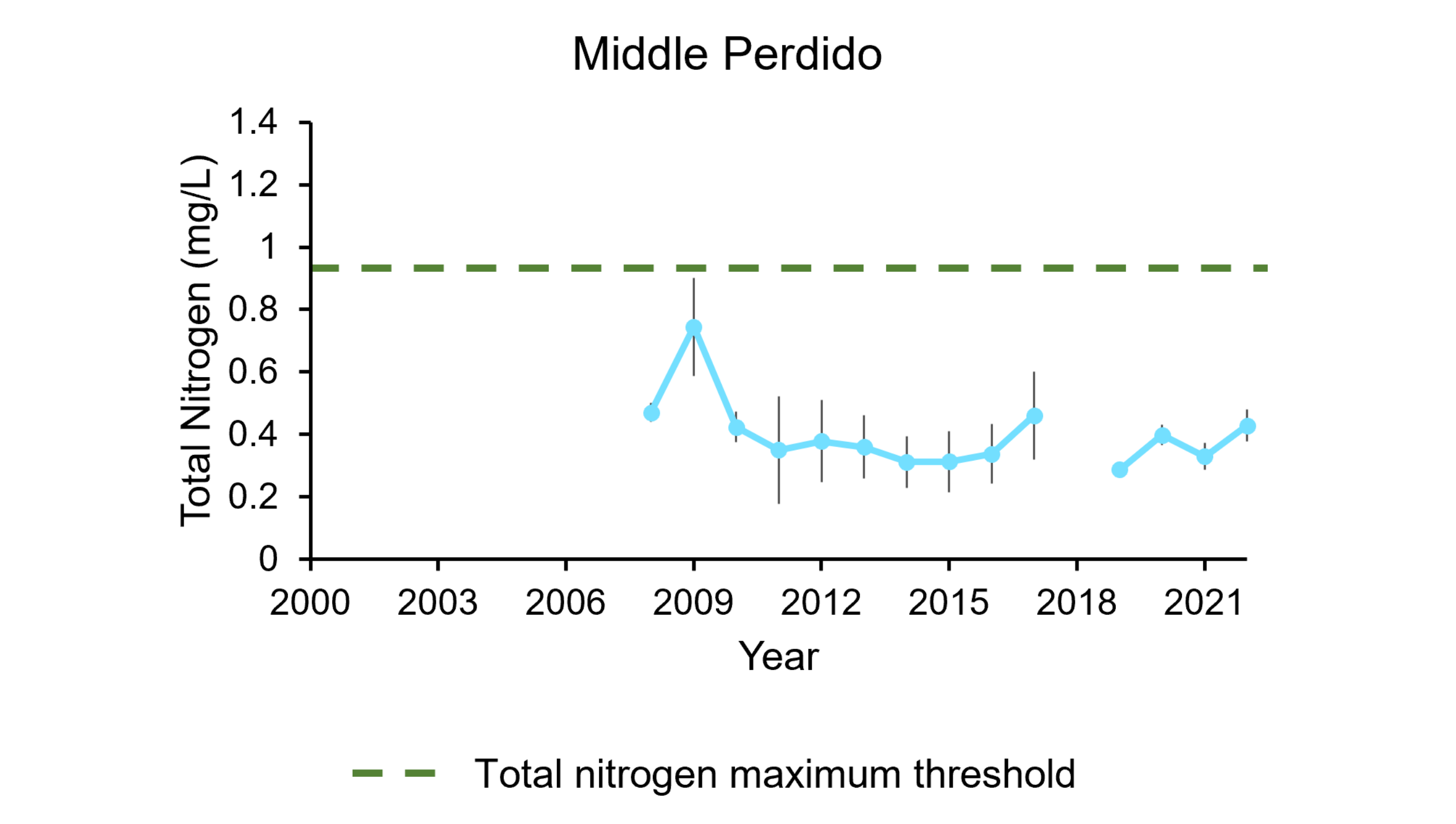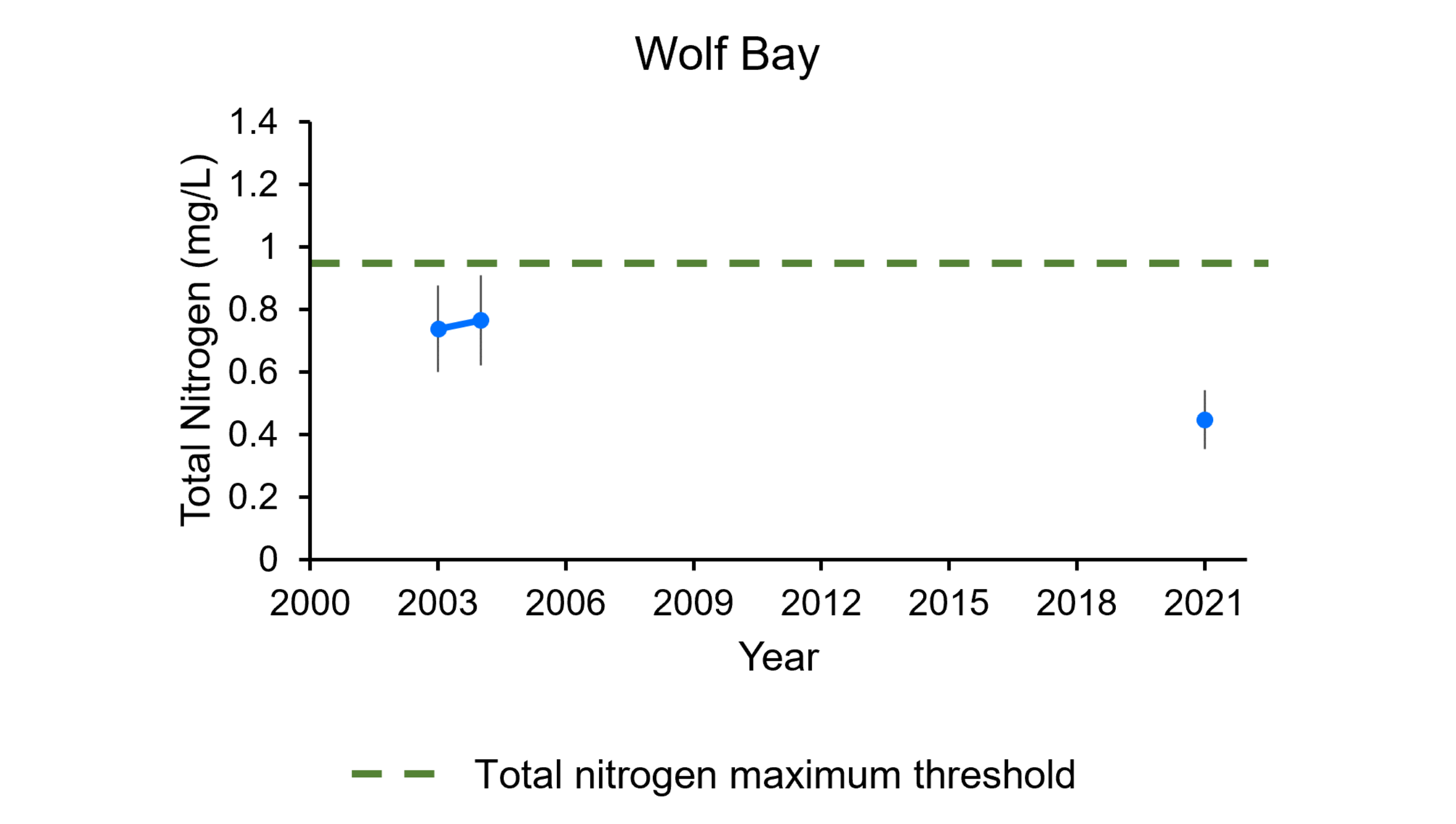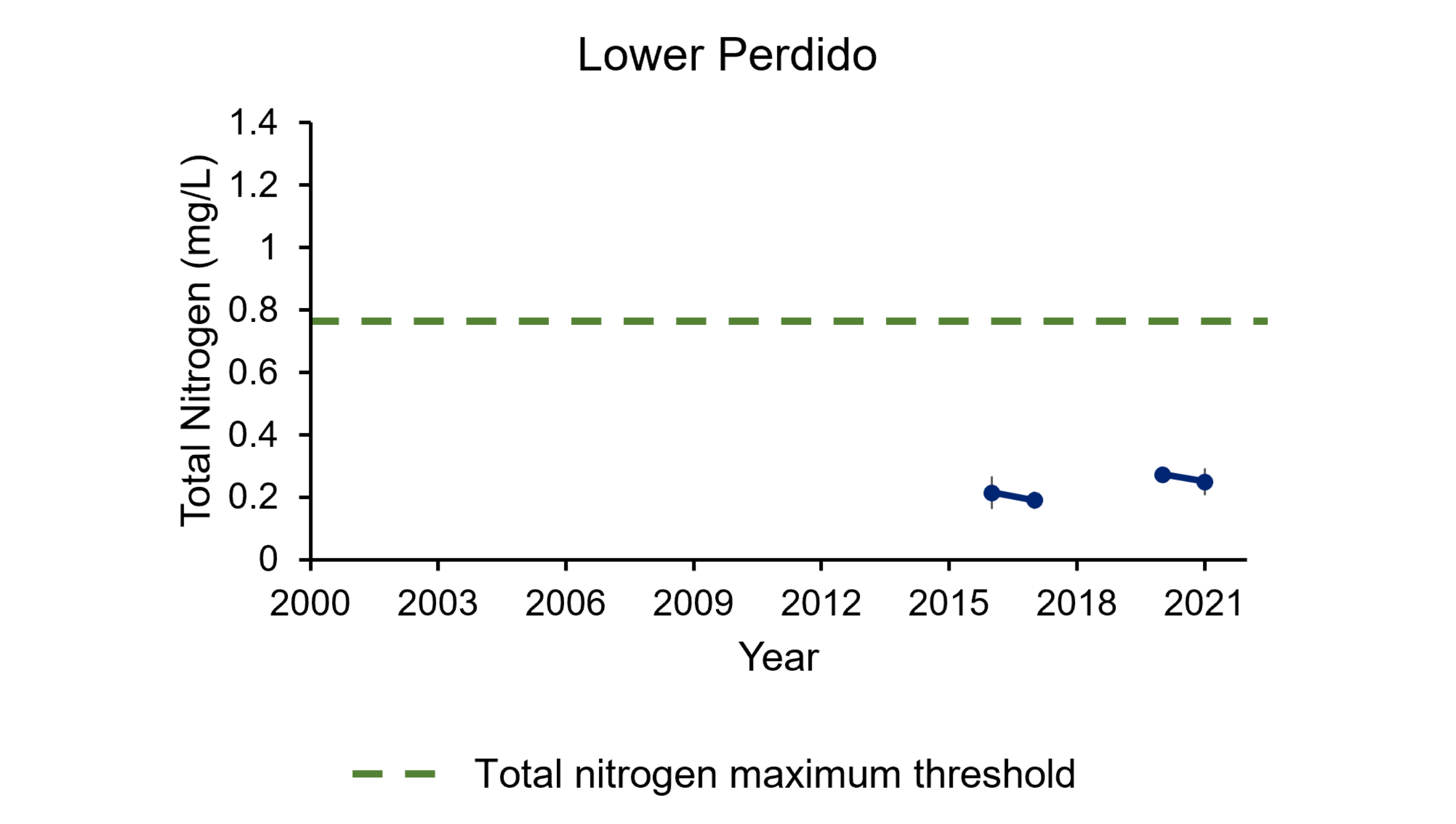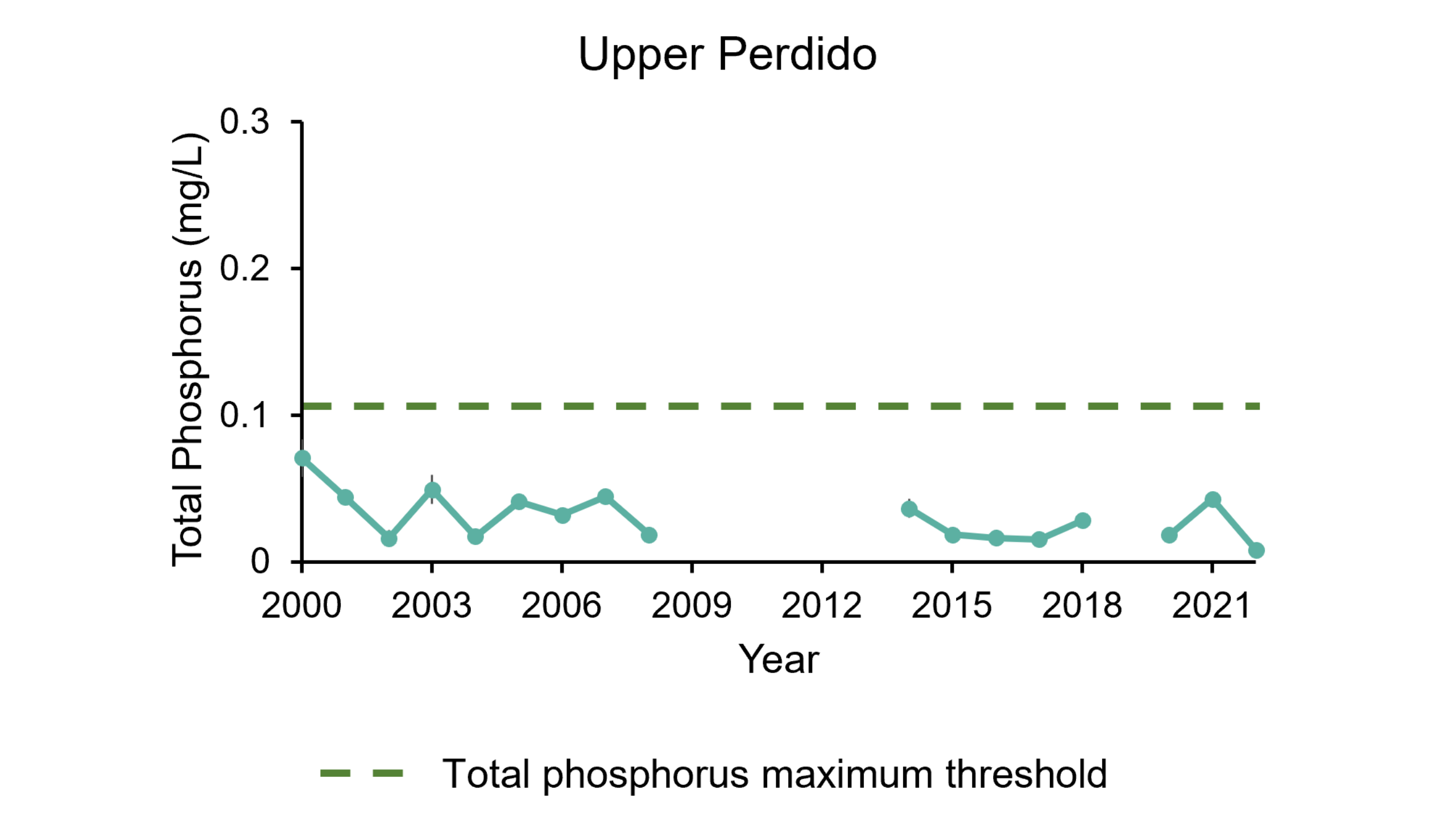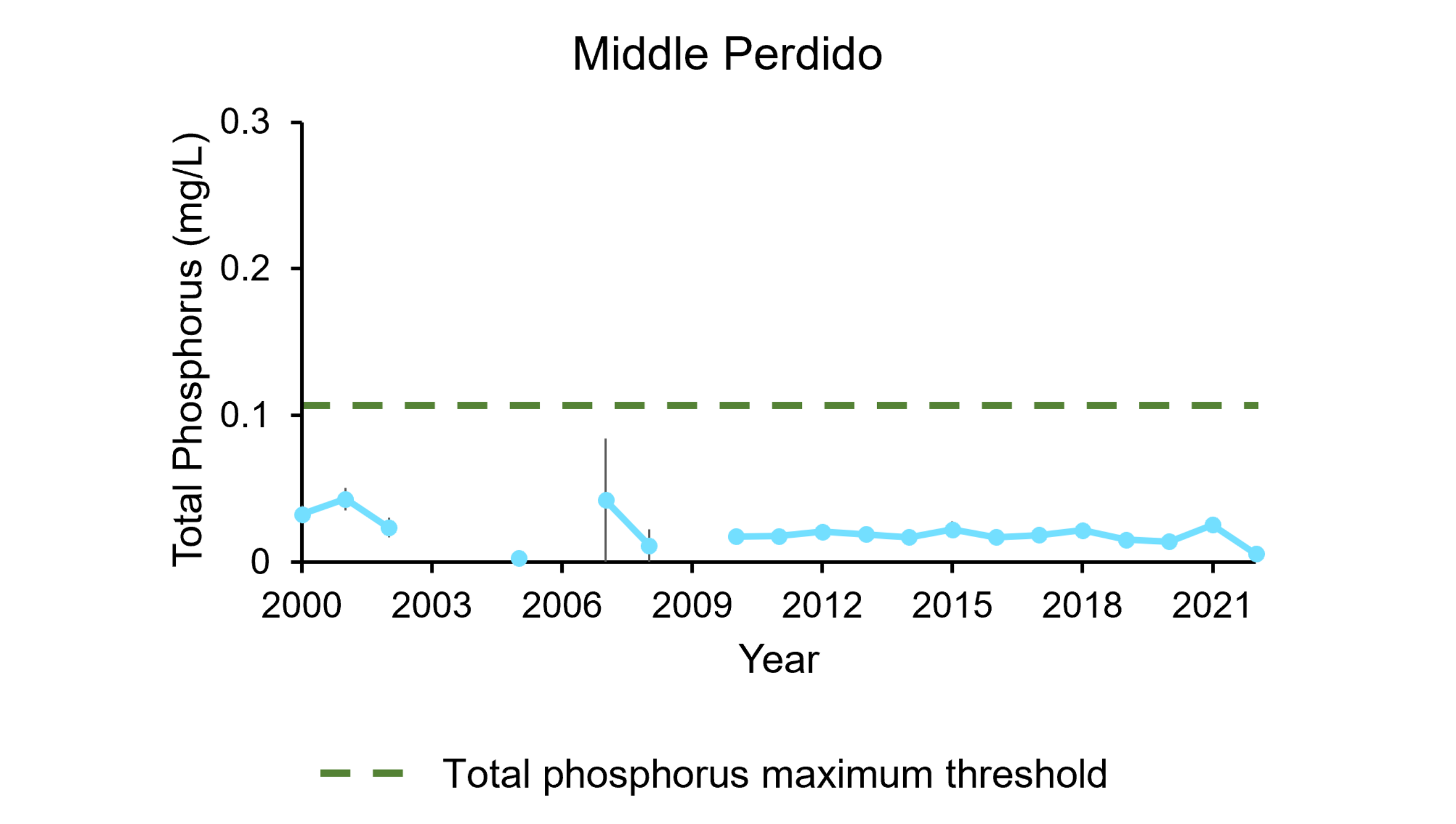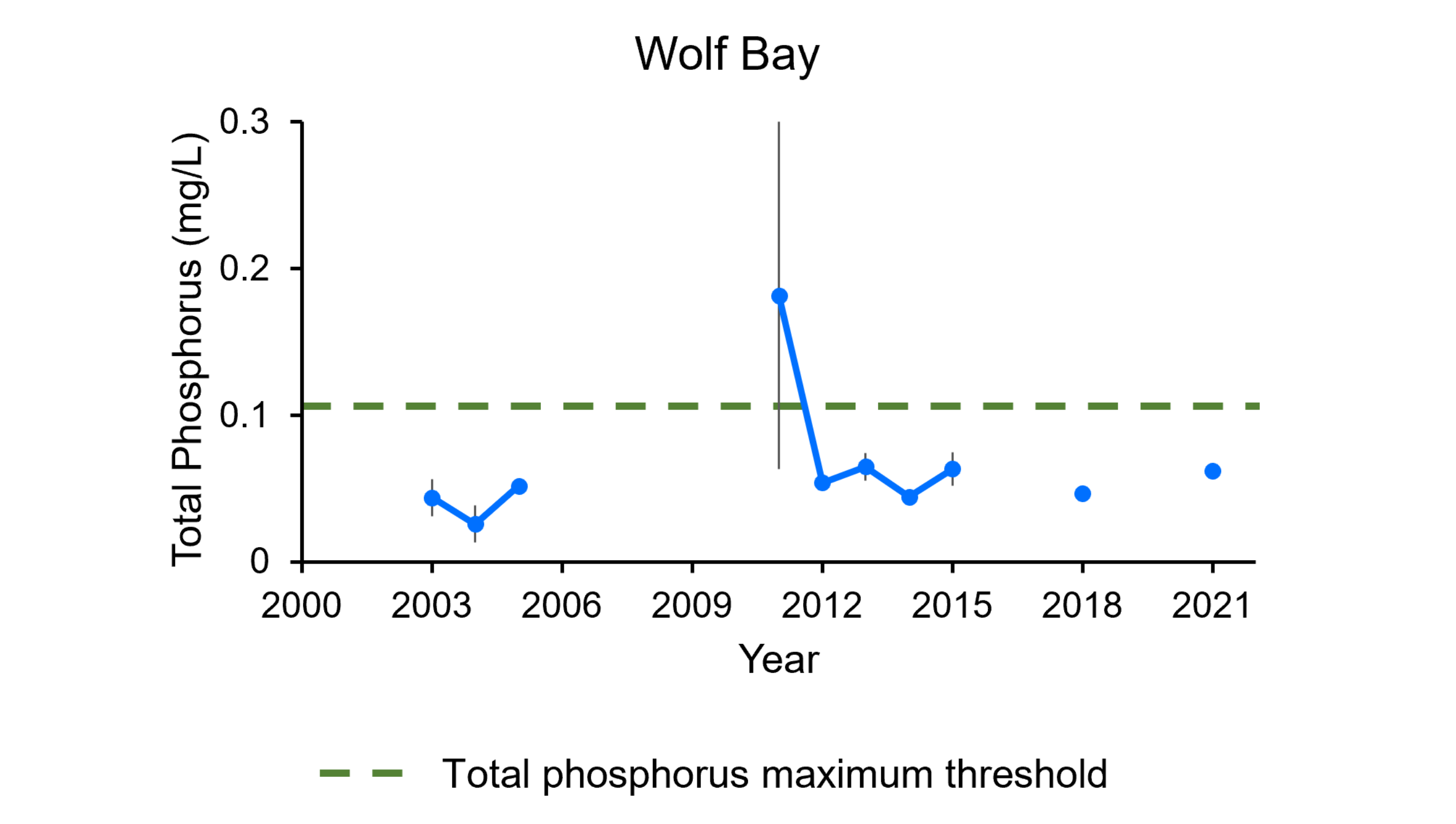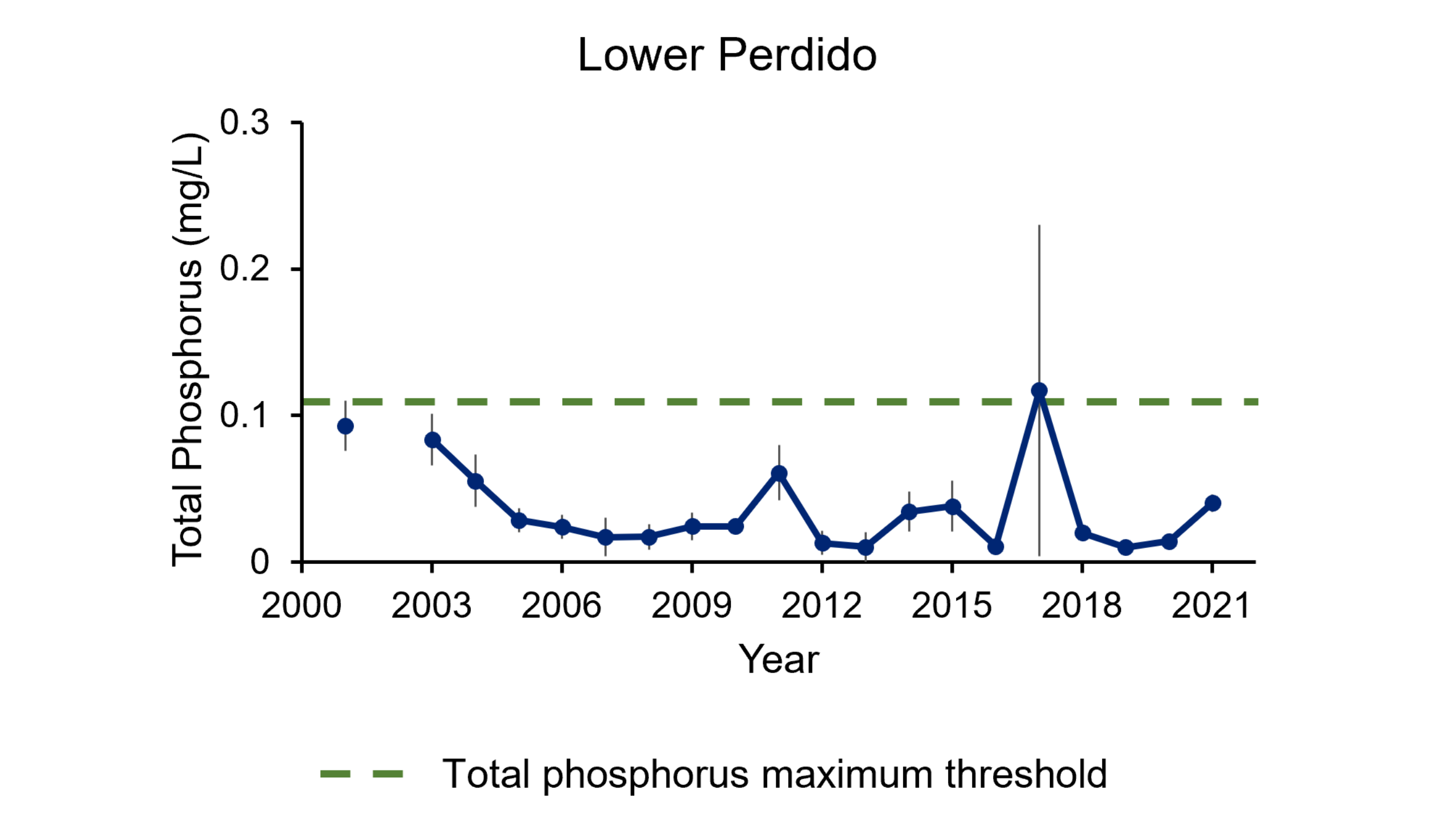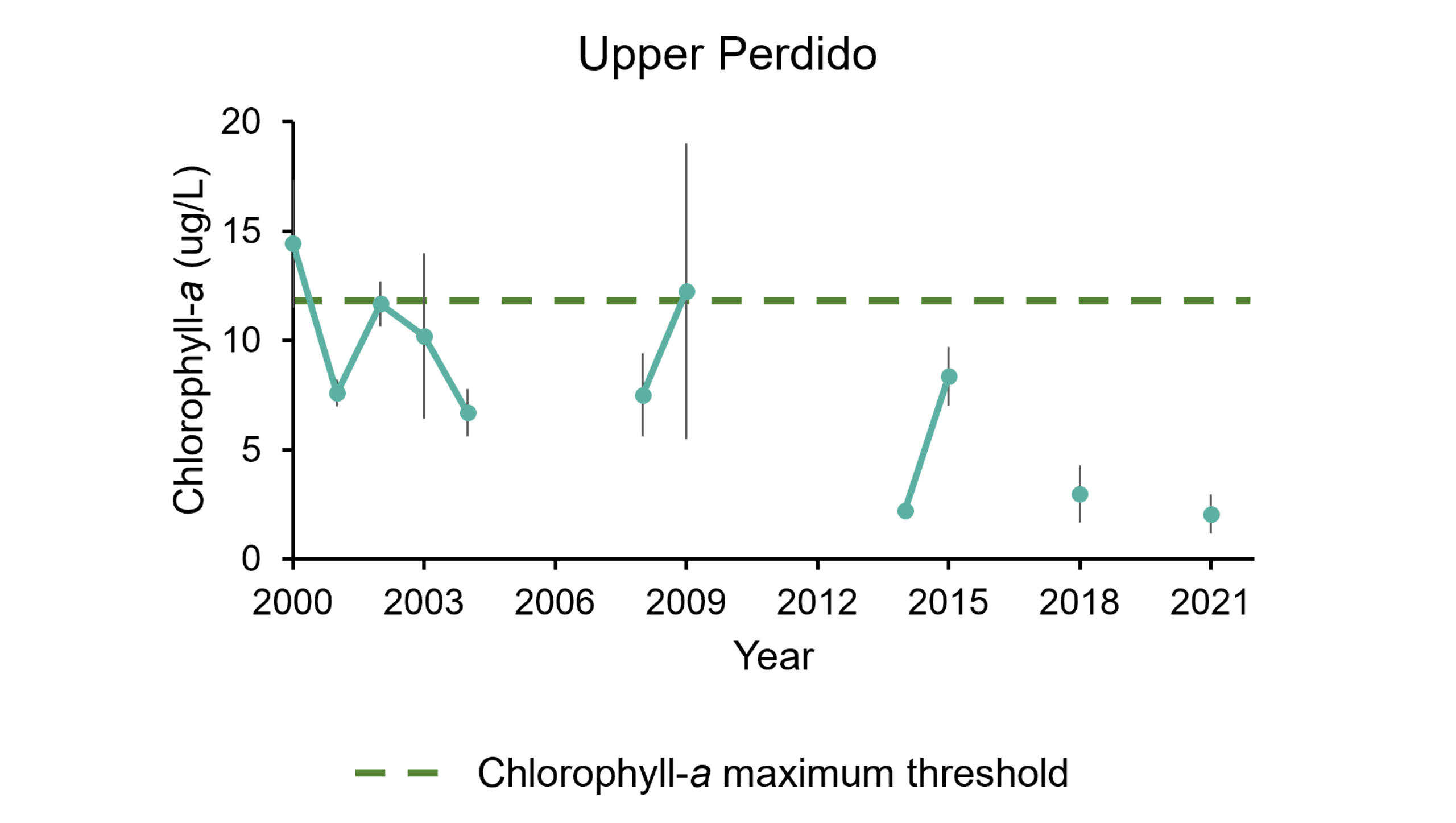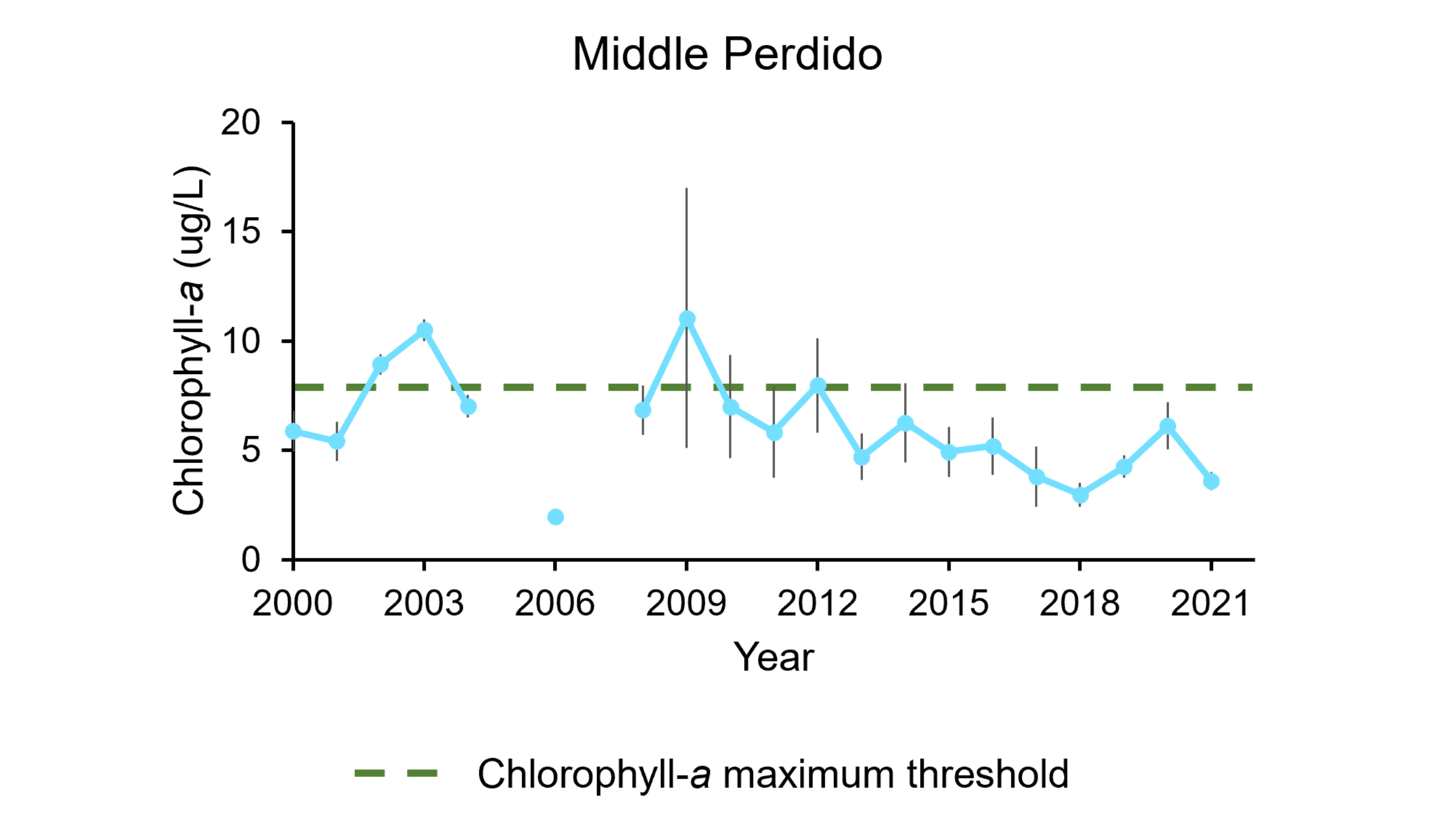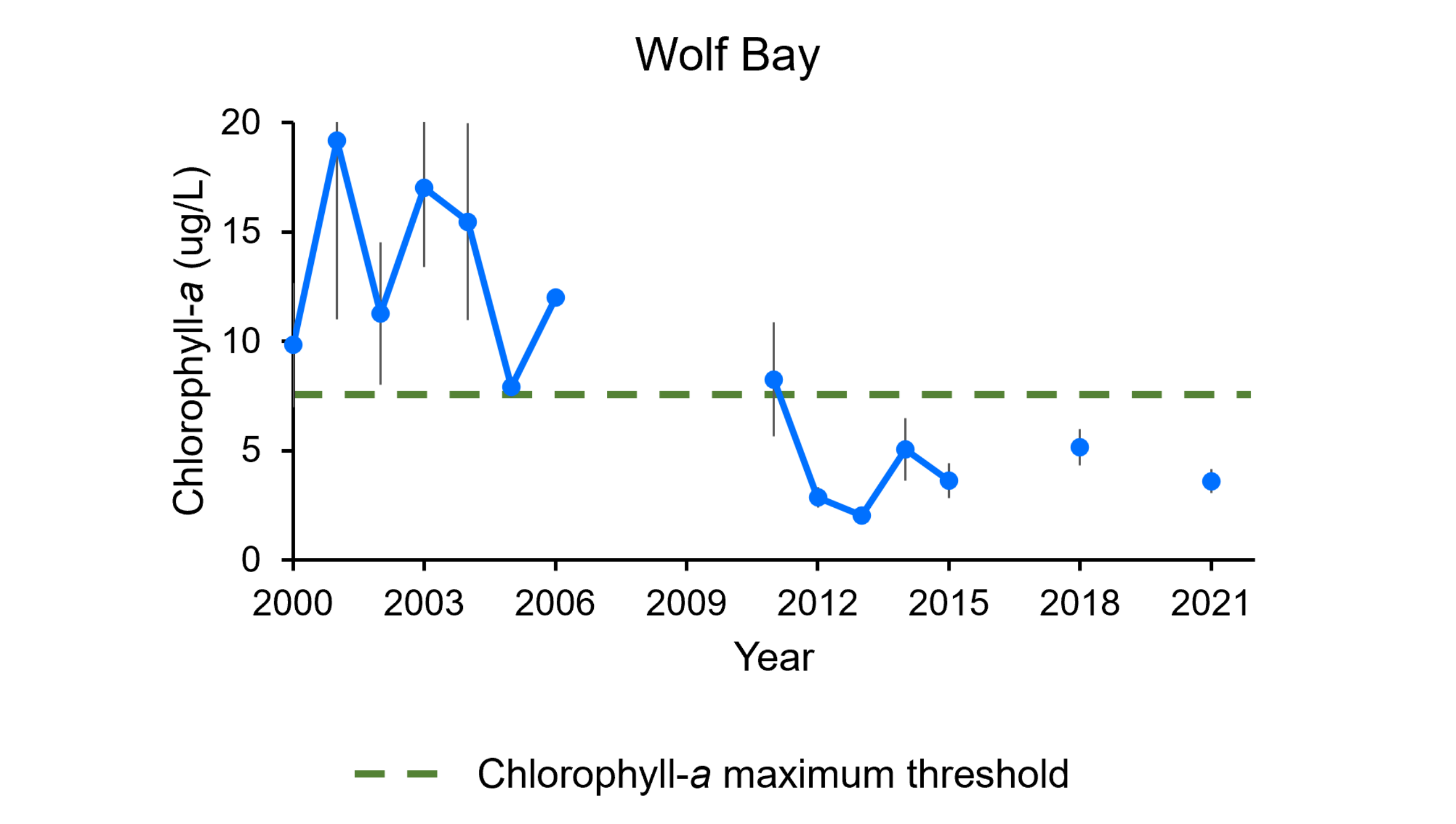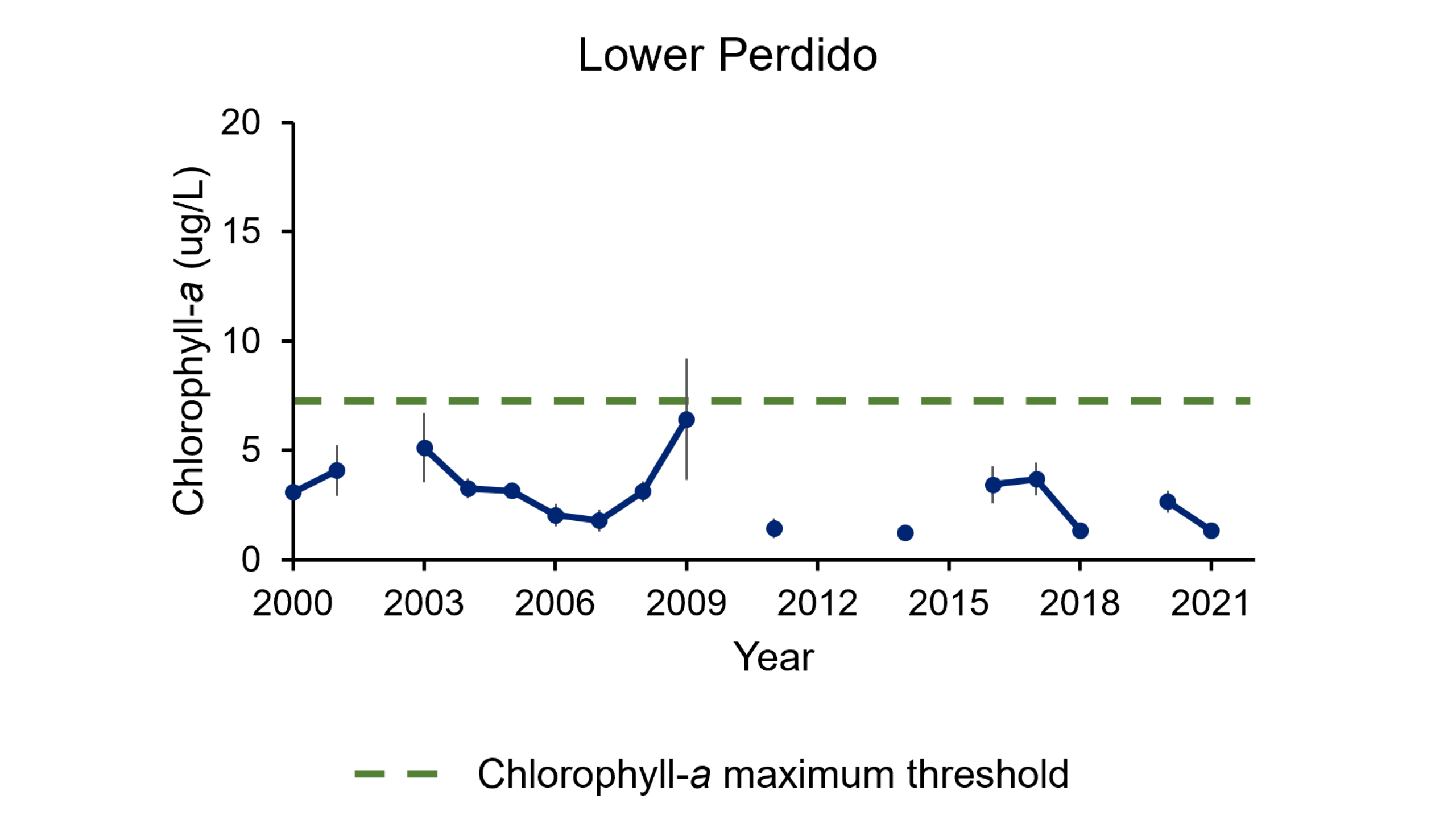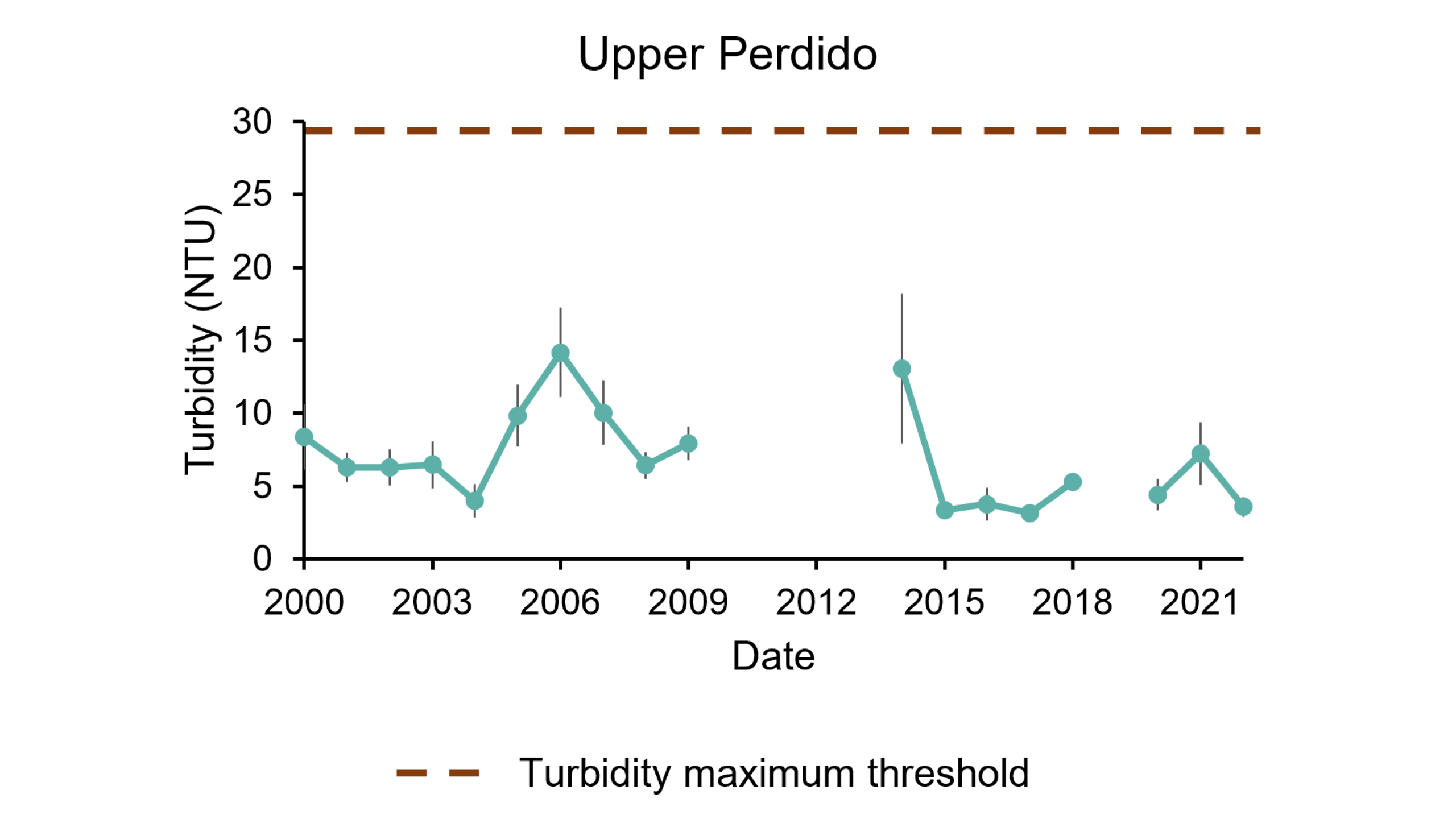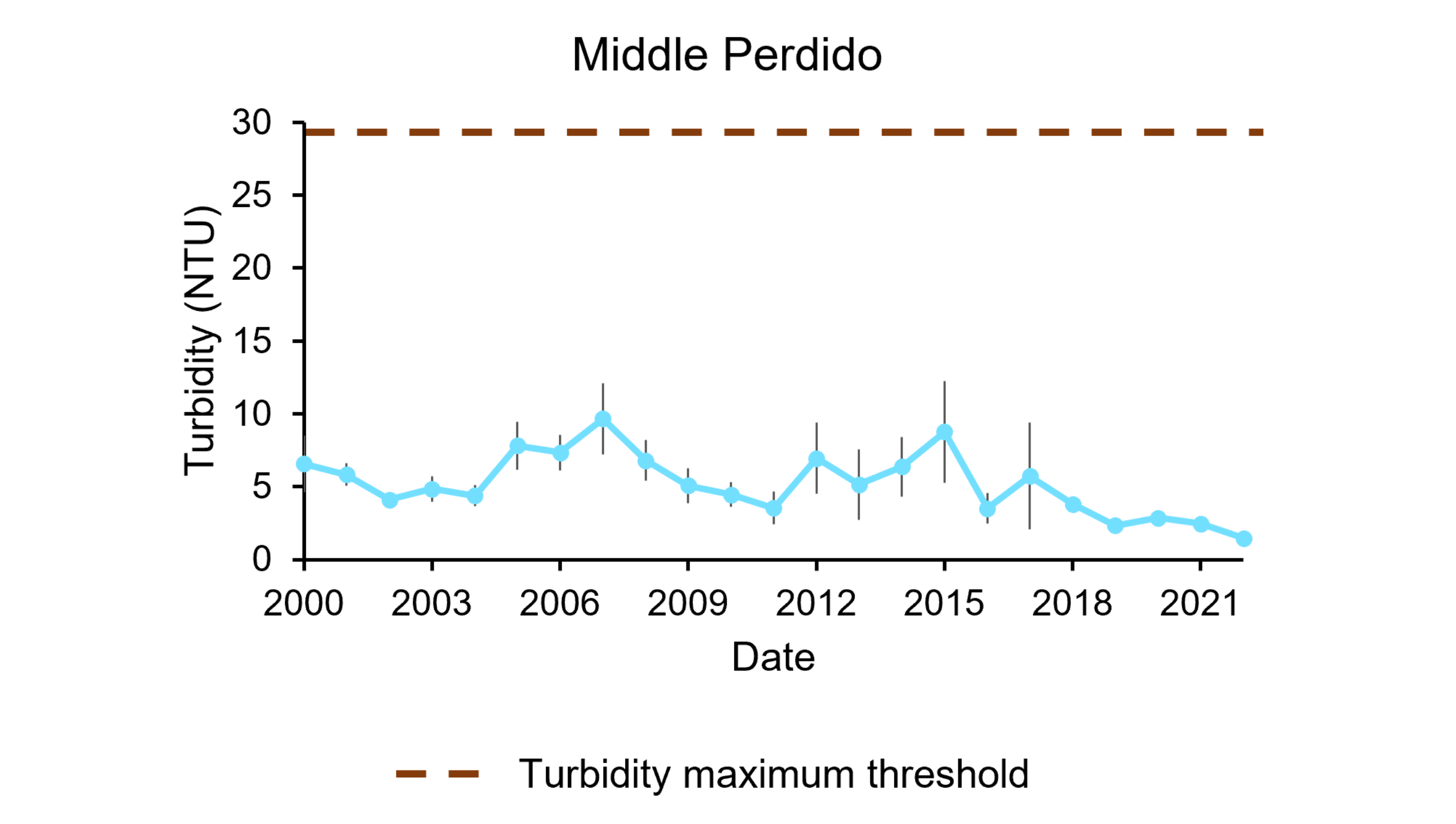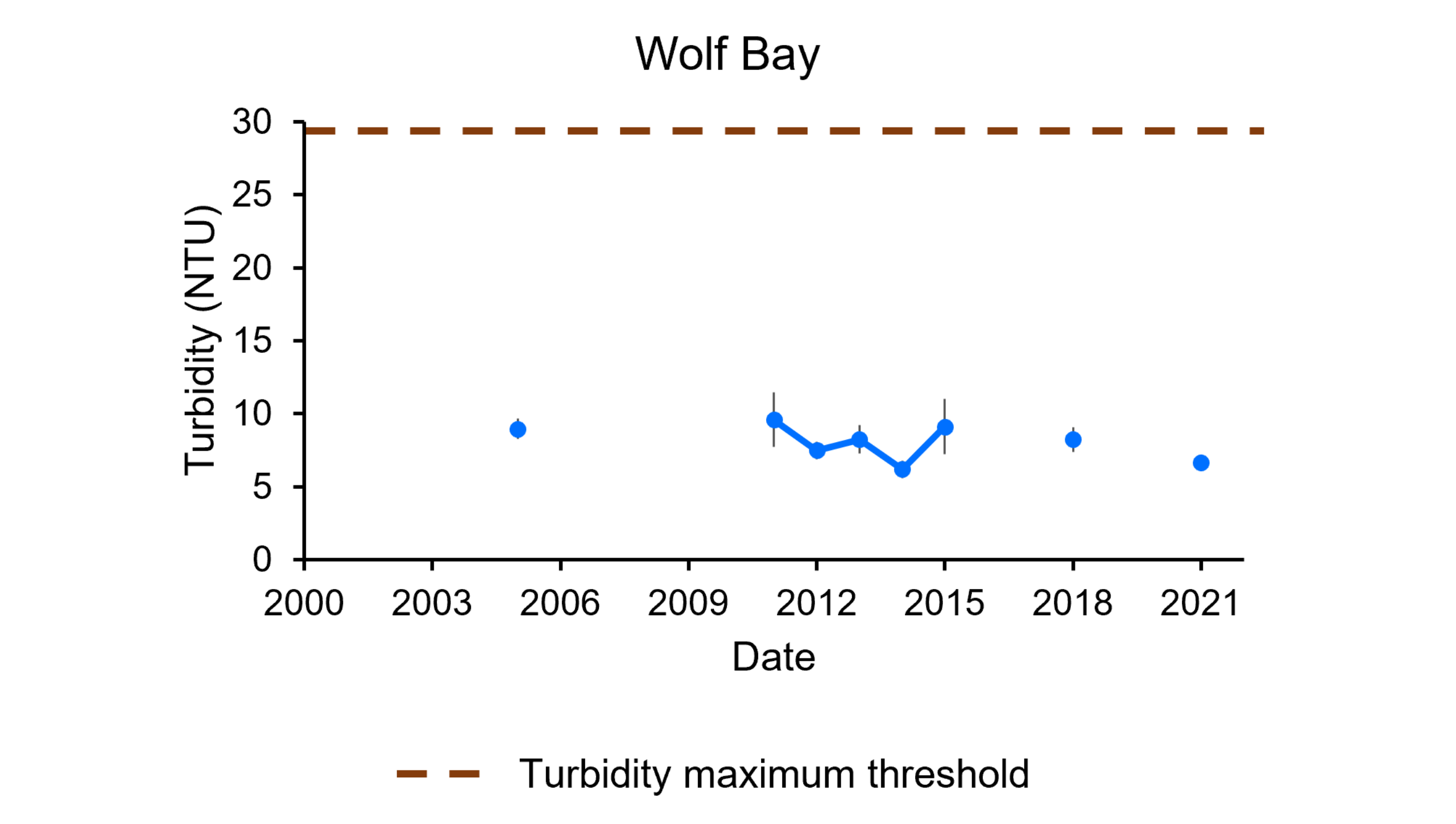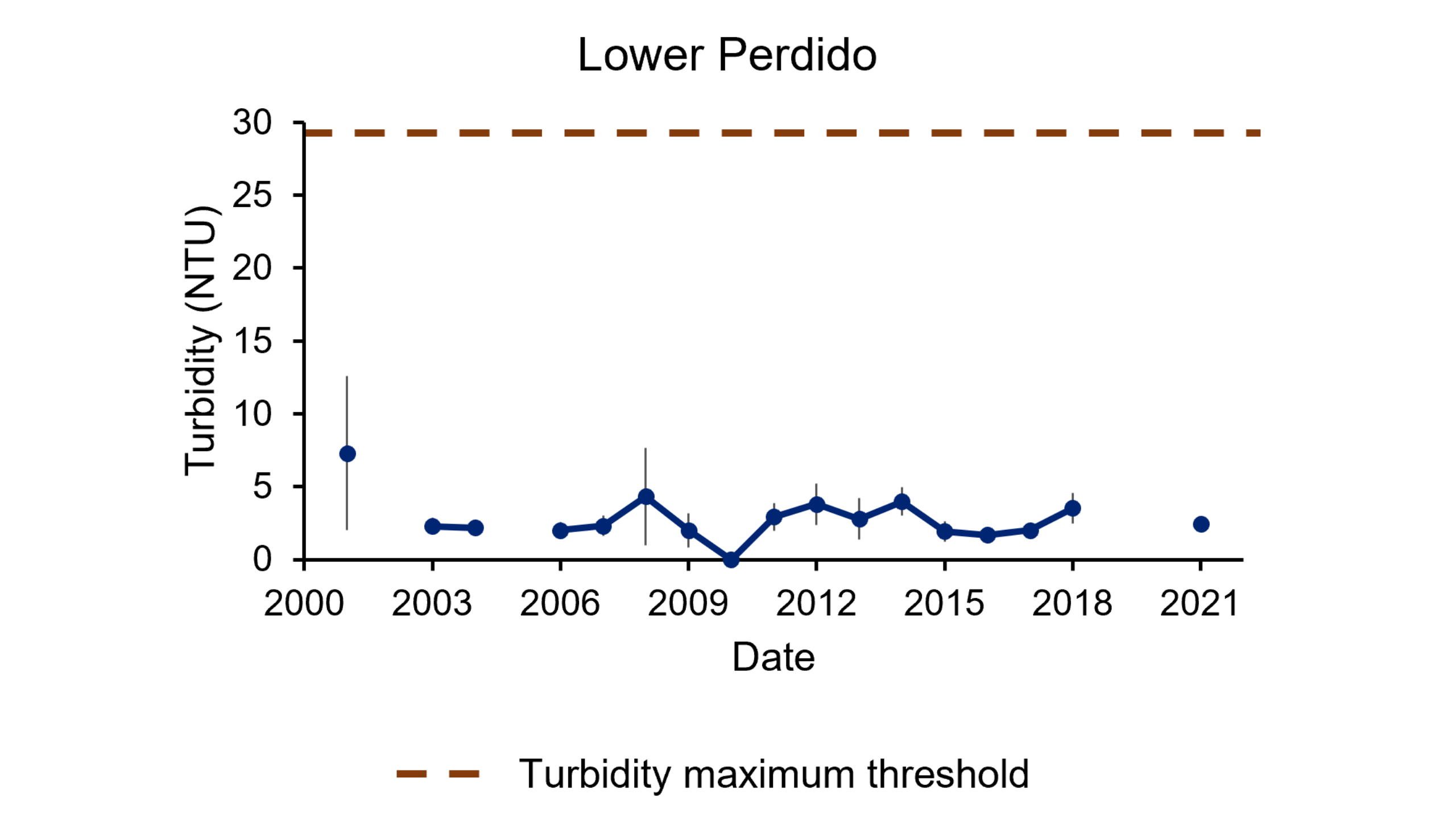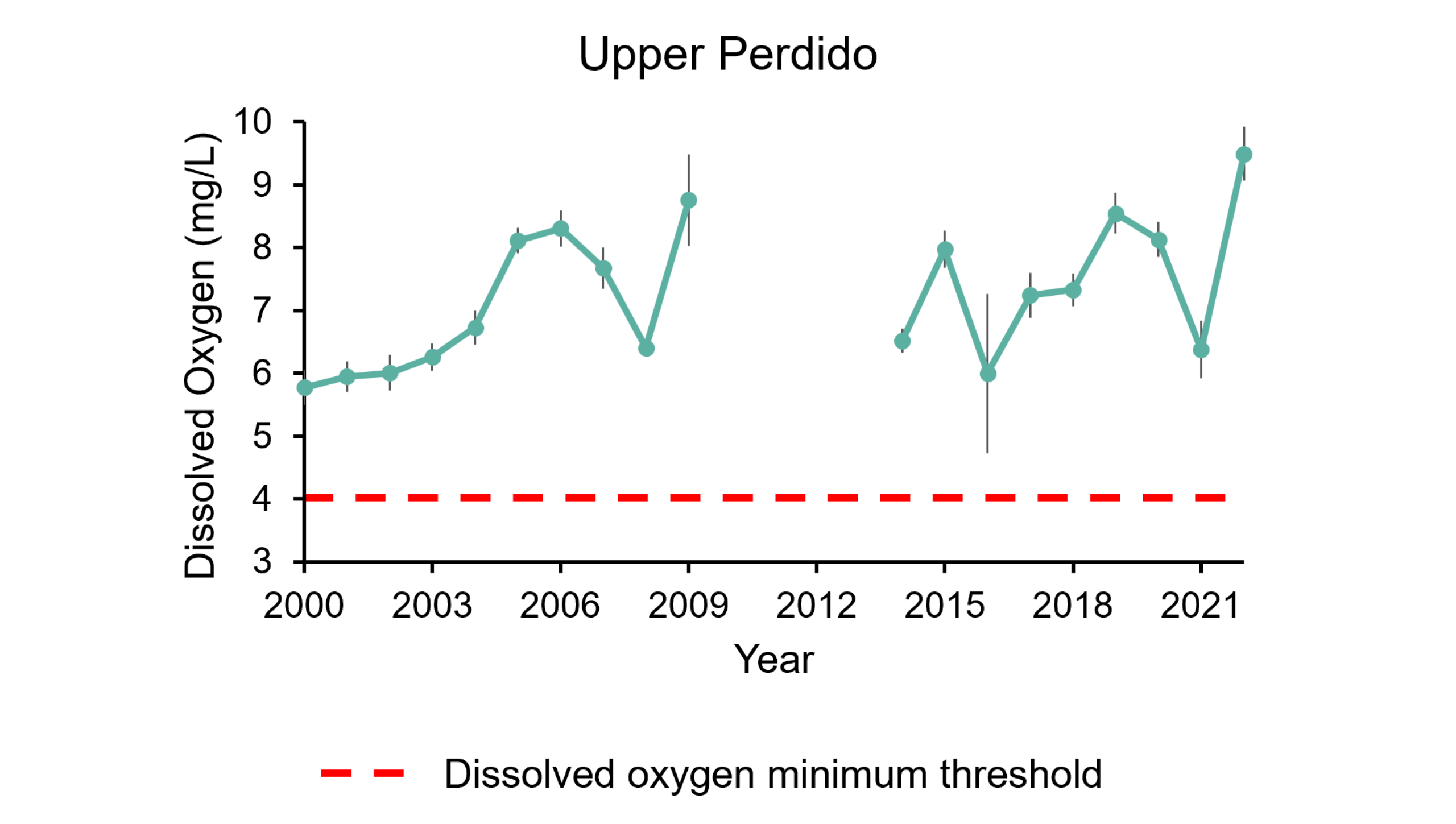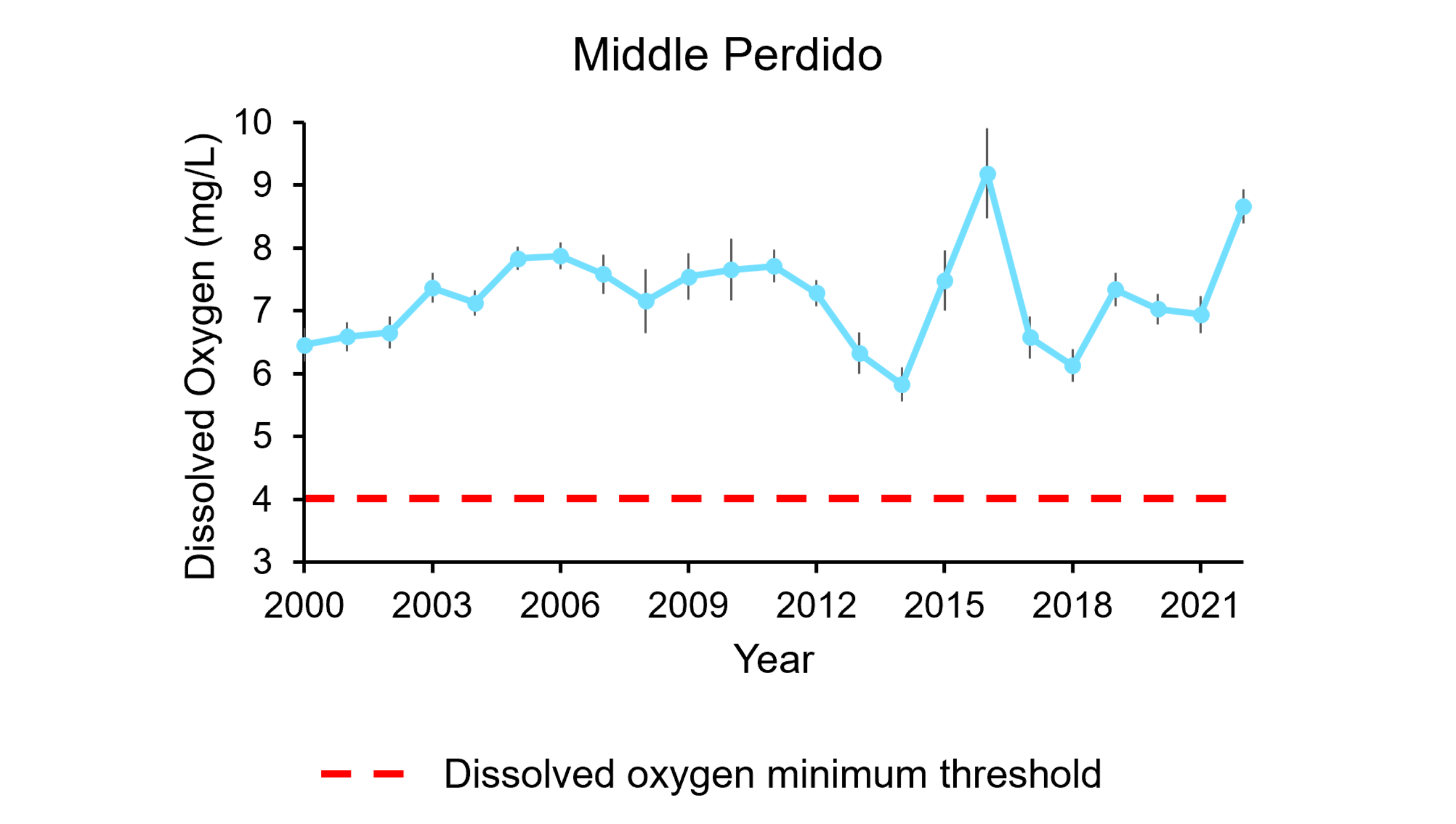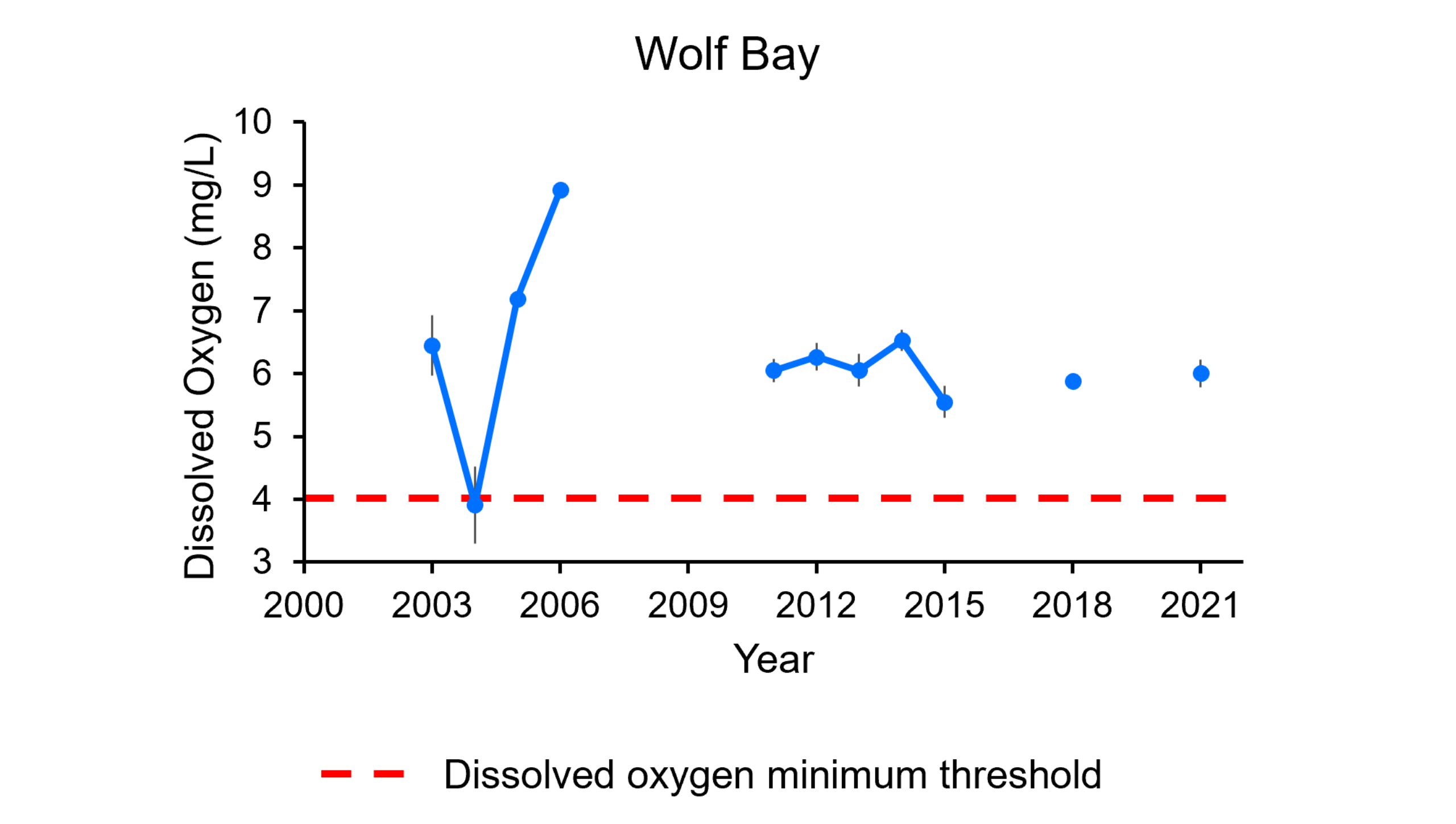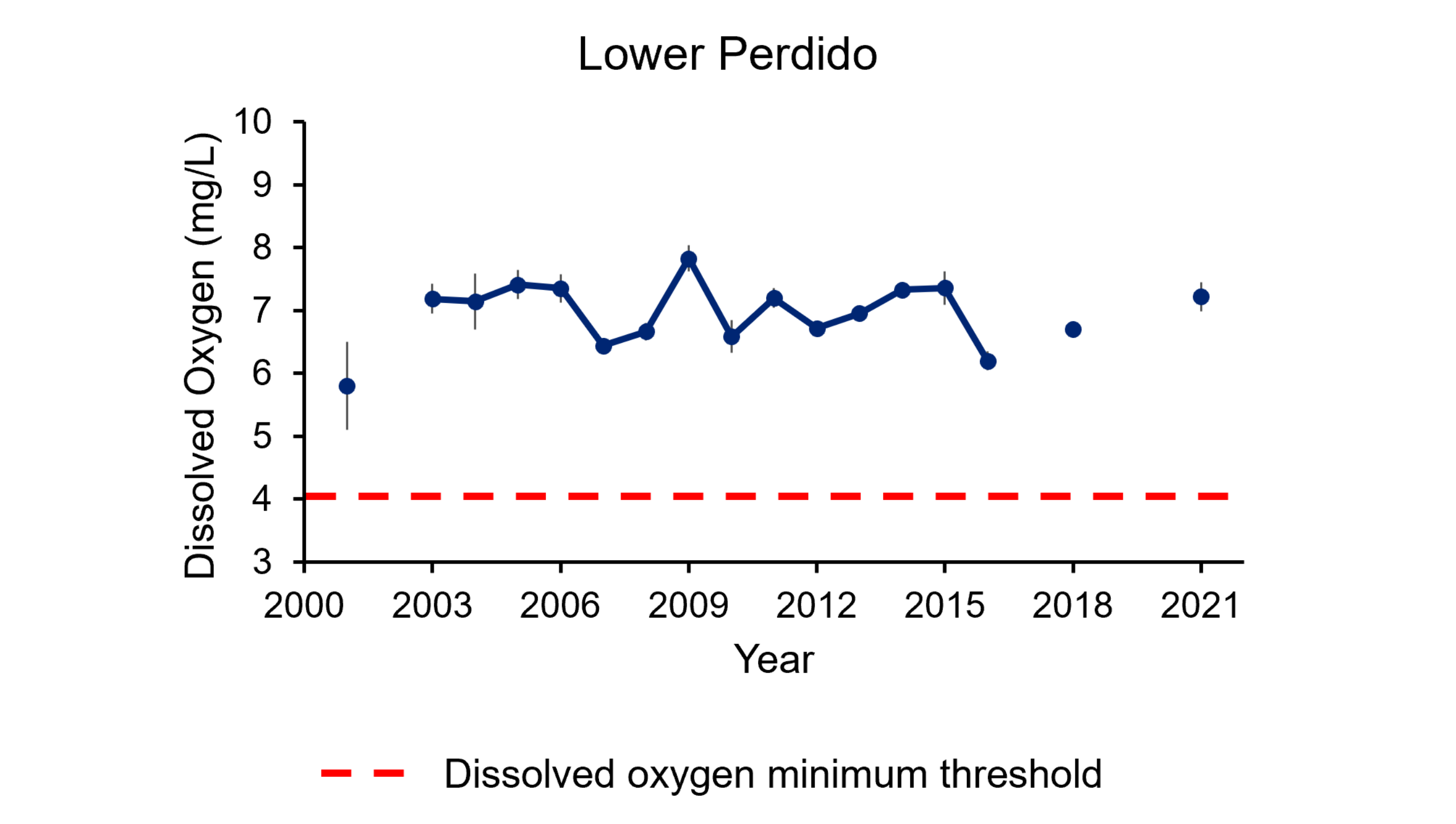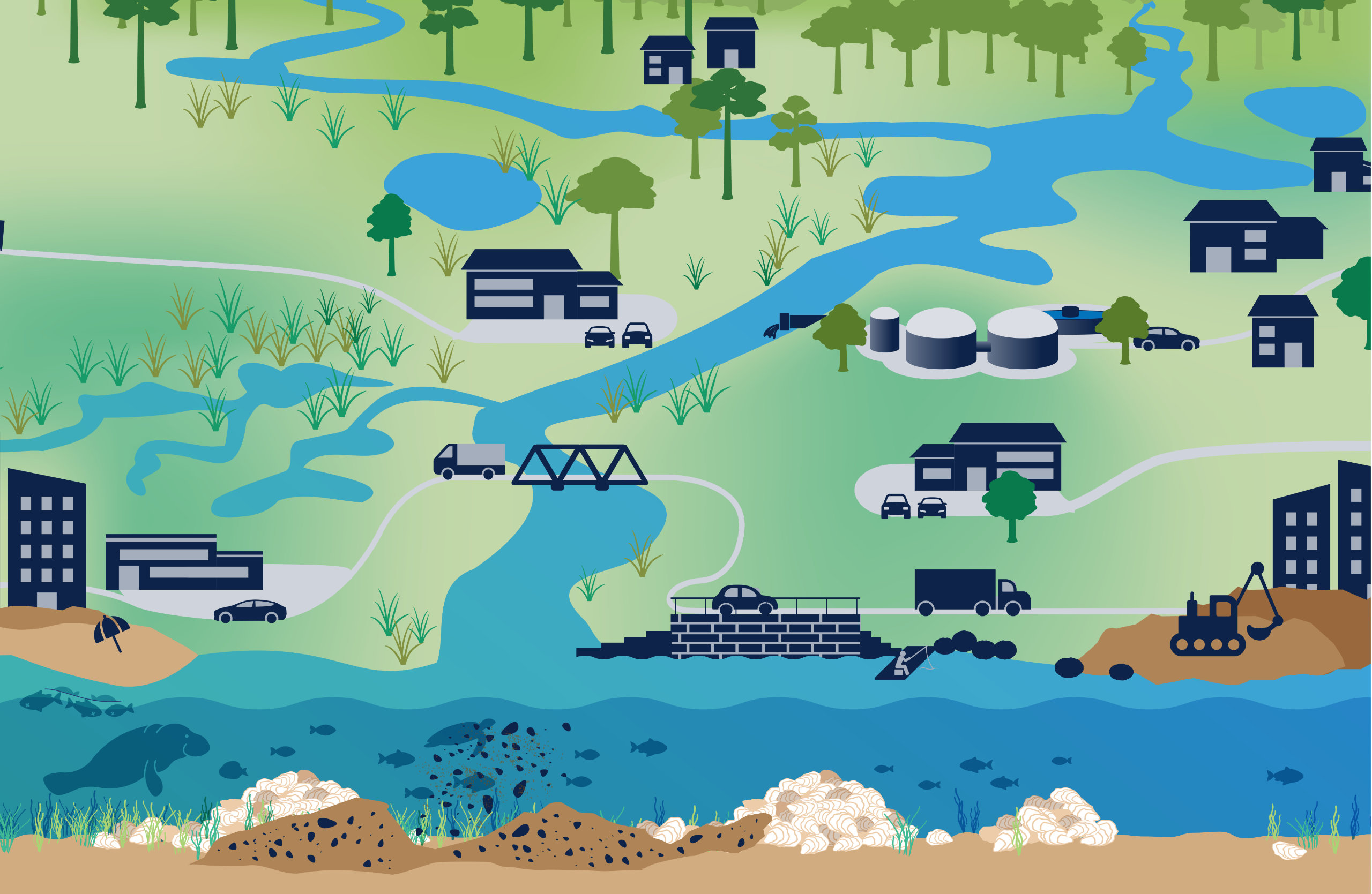

Water Quality in our Watersheds

Nitrogen:
Nitrogen is a nutrient from waste, fertilizers, and runoff that can be harmful in excess amounts and cause algal blooms and declines in water quality.

Phosphorus:
Phosphorous is a nutrient from waste, fertilizers, and runoff that can be harmful in excess amounts and cause algal blooms and declines in water quality.

Turbidity:
Particles in the water column can reduce water clarity and the amount of light available for photosynthesis. High turbidity can negatively impact aquatic plants and animals.

Chlorophyll-a:
Chlorophyll-a is a measure of microscopic algal growth. Algae produce oxygen and food for animals, but can reduce the amount of light reaching the bottom when present in excess.

Dissolved Oxygen:
Low levels of oxygen in the water column can stress wildlife and may cause fish and shellfish die-offs in extreme cases. Low dissolved oxygen can occur after algal blooms as a result of algal decomposition.
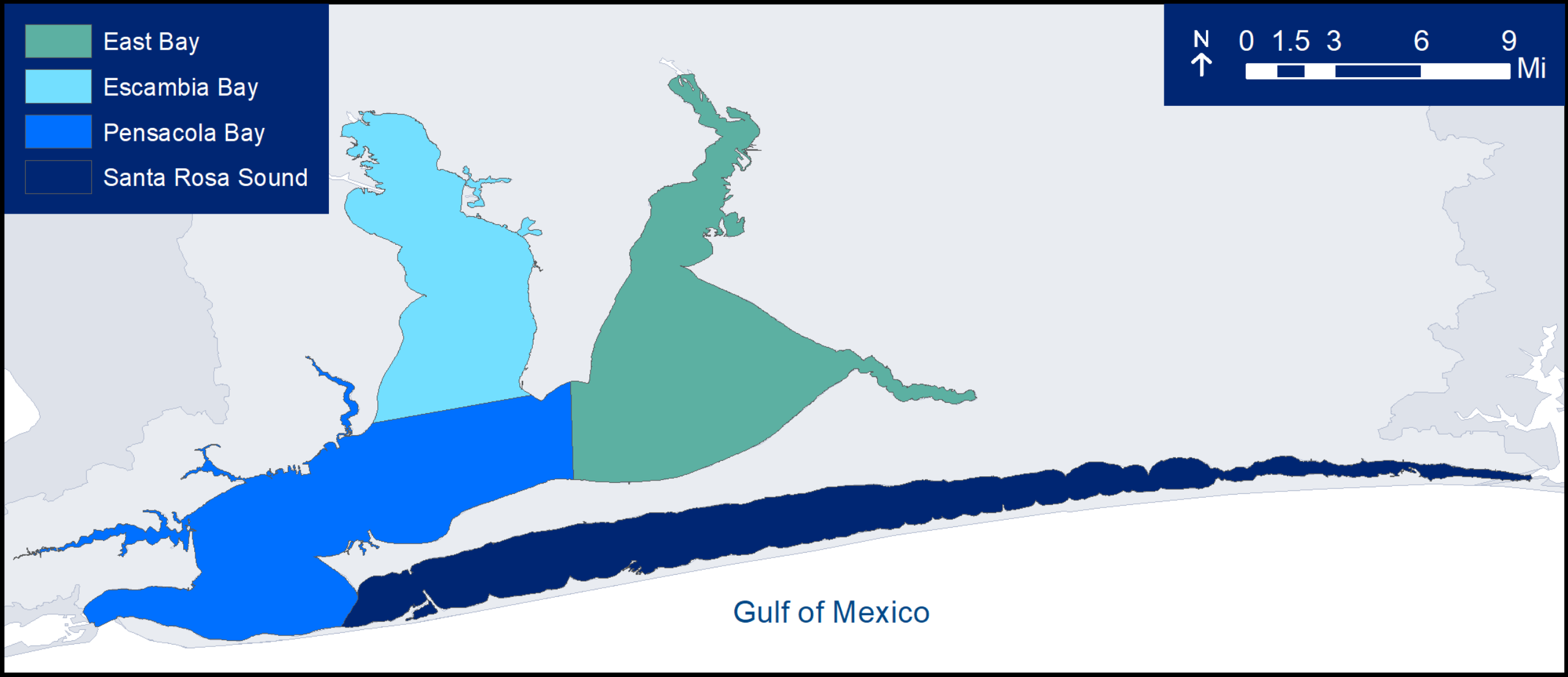

Pensacola Bay
Nitrogen

Nitrogen is an essential nutrient for the growth of all organisms in the bay. Excess nitrogen from agricultural and stormwater runoff and wastewater discharges can fuel algal blooms. These blooms can block sunlight from reaching underwater grasses and use up oxygen when they die and decompose. During heavy rain, water washes nitrogen off the land from farmland and hardened surfaces (like paved parking lots) and funnels the excess nitrogen into the bay. We can help reduce the amount of nitrogen in our waterways and improve water quality by protecting our wetlands and forests, which help filter the water.
- Overall, nitrogen concentrations have been stable
- Recently, most of the bay has seen an increase in nitrogen concentrations, indicating a decline in water quality
- Escambia Bay historically had the highest nitrogen concentrations, but began to improve from 2008-2019
- Recently, nitrogen concentrations in Escambia Bay have started to increase
- Sampling frequency and methodology differ among groups that monitor water quality
- Improved coordination among agencies, non-profits, researchers, etc., will be key to evaluate long-term nitrogen trends
How you can protect water quality
- Practice smart fertilizer use
- Don’t fertilize right before a rainstorm
- Sweep or blow grass clippings and excess fertilizer from driveways and streets back onto the lawn
- Never fertilize within 10 feet of a waterbody
- Learn More!
- Maintain your septic tanks and lateral lines
- Maintain vegetated barriers that act as buffers along wetland edges and streambanks
- Keep shorelines soft and living
- Support water quality monitoring and improvements! Donate here!

Pensacola Bay
Phosphorus

Phosphorus is an essential nutrient for the growth of all organisms in the bay. Excess phosphorus from agricultural and stormwater runoff and wastewater discharges can fuel algal blooms. These blooms can block sunlight from reaching underwater grasses and use up oxygen when they die and decompose. During heavy rain, water washes phosphorus off the land from farmland and hardened surfaces (like paved parking lots) and funnels the excess phosphorus into the bay. We can help reduce the amount of phosphorus in our waterways and improve water quality by protecting our wetlands and forests, which help filter the water.
- Phosphorus thresholds vary by bay segment
- Thresholds vary due to different environmental conditions
- Santa Rosa Sound frequently exceeded the phosphorus threshold prior to 2015
- Phosphorus thresholds have not been exceeded in East, Escambia, and Pensacola Bays
- Recently, phosphorus concentrations have decreased, indicating water quality improvements
How you can help protect water quality
- Practice smart fertilizer use
- Don’t fertilize right before a rainstorm
- Sweep or blow grass clippings and excess fertilizer from driveways and streets back onto the lawn
- Never fertilize within 10 feet of a waterbody
- Learn More!
- Maintain your septic tanks and lateral lines
- Maintain vegetated barriers that act as buffers along wetland edges and streambanks
- Keep shorelines soft and living
- Support water quality monitoring and improvements! Donate here!

Pensacola Bay
Chlorophyll-a

Chlorophyll-a is a measure of microscopic algal growth. During heavy rain, water washes nutrients off the land from farmland and hardened surfaces (like paved parking lots) and funnels the excess nutrients into the bay. Excess nutrients from agricultural and stormwater runoff and wastewater discharges can fuel algal blooms. When these algae are in excess during blooms, the water becomes cloudy, starving underwater grasses and animals from the light they need for growth. Once these blooms die, the algal cells decompose, which uses oxygen in the water column and stresses oxygen-dependent life.
- Chlorophyll-a thresholds vary by bay segment
- Thresholds vary due to different environmental conditions
- The majority of bay segments have had relatively stable chlorophyll-a concentrations
- Santa Rosa Sound and East Bay have had the lowest chlorophyll-a concentrations
- Escambia Bay has the highest chlorophyll-a concentrations, and frequently exceeds the maximum threshold, indicating poor water quality
- This region of the Pensacola Bay System had historically been impacted by industry
- Escambia River is the largest river in the Pensacola watershed and drains large forest and agricultural areas
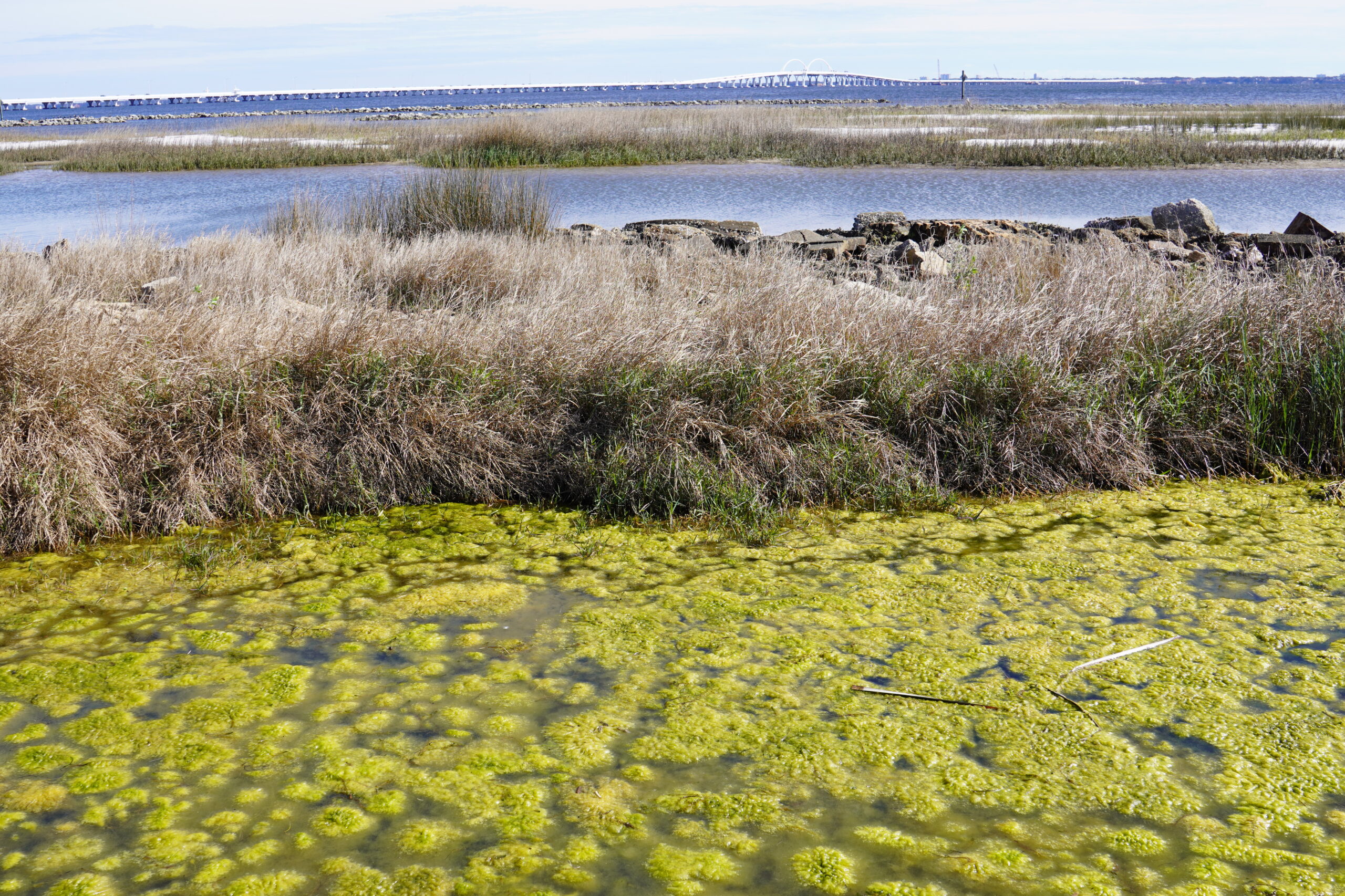
How you can help protect water quality
- Practice smart fertilizer use
- Don’t fertilize right before a rainstorm
- Sweep or blow grass clippings and excess fertilizer from driveways and streets back onto the lawn
- Never fertilize within 10 feet of a waterbody
- Learn More!
- Maintain your septic tanks and lateral lines
- Maintain vegetated barriers that act as buffers along wetland edges and streambanks
- Keep shorelines soft and living
- Support water quality monitoring and improvements! Donate here!

Pensacola Bay
Turbidity

Turbidity is a measure of how cloudy the water is and represents particles in the water column. High turbidity can be caused by poor development and construction practices, and runoff from farms, dirt roads, etc. Cloudy water results in shading of light-sensitive plants and animals that need light for growth. A high concentration of particles in the water column can also affect filter feeders, like oysters, and contribute to sediment build up over time, eventually smothering bottom plants and animals.
- In recent years turbidity is decreasing, indicating improved water quality
- Though not exceeding threshold concentrations, Escambia Bay has the highest turbidity
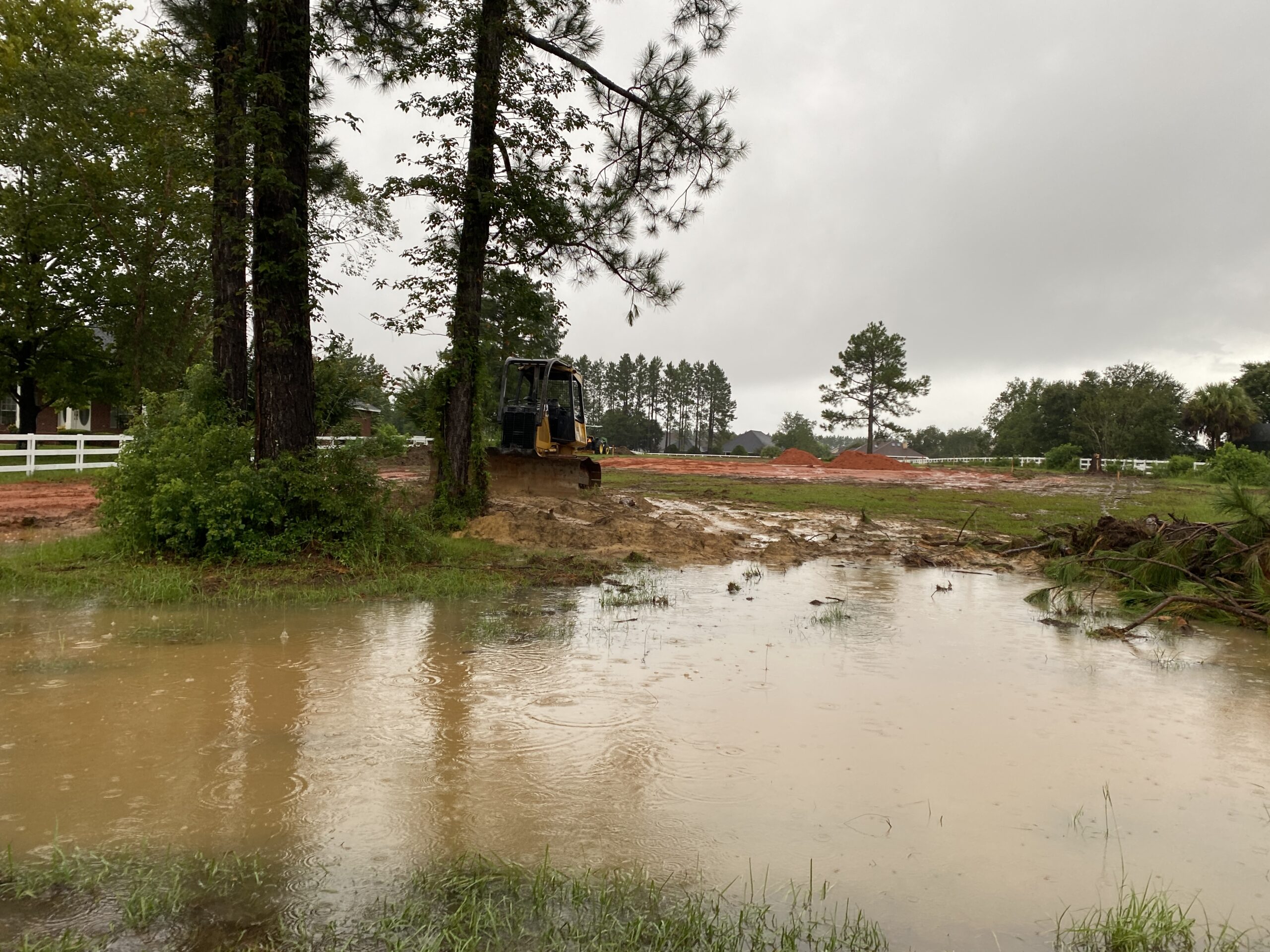
How you can help protect water quality
- Maintain vegetated barriers that act as buffers along wetland edges and streambanks
- Keep shorelines soft and living
- Avoid loose soil on your property. Mulch in gardens can help keep soil in its place
- Talk to your local elected officials! Well-written land development codes can help reduce the impacts of development
- Support water quality monitoring and improvements! Donate here!

Pensacola Bay
Dissolved Oxygen

Oxygen is essential for life within the bay. When large algal blooms die-off, bacteria that decompose the algae consume large amounts of oxygen. Temperature and freshwater discharge are other factors that affect dissolved oxygen levels. During the summer, denser, saltier water sinks to the bottom, while less dense, fresh water stays on top. This layering reduces the mixing between surface and bottom waters, reducing the amount of oxygen in the bottom layer. Warmer water also holds less oxygen, making low dissolved oxygen more common during the summer months.
- All bay segments have increased in dissolved oxygen concentrations, indicating improved water quality
- While no bay segment has dipped below the minimum threshold needed to sustain life, East Bay dipped to ~5 mg/L in the mid-2000s and 2015, potentially threatening oysters
- Dissolved oxygen shown here represent surface waters due to lack of bottom water monitoring data
- Bottom water dissolved oxygen is more important to sensitive bottom plants and animals. It is important to measure bottom water dissolved oxygen because it does not always match surface levels
How you can help protect water quality
- Practice smart fertilizer use
- Don’t fertilize right before a rainstorm
- Sweep or blow grass clippings and excess fertilizer from driveways and streets back onto the lawn
- Never fertilize within 10 feet of a waterbody
- Learn More!
- Maintain your septic tanks and lateral lines
- Maintain vegetated barriers that act as buffers along wetland edges and streambanks
- Keep shorelines soft and living
- Support water quality monitoring and improvements! Donate here!
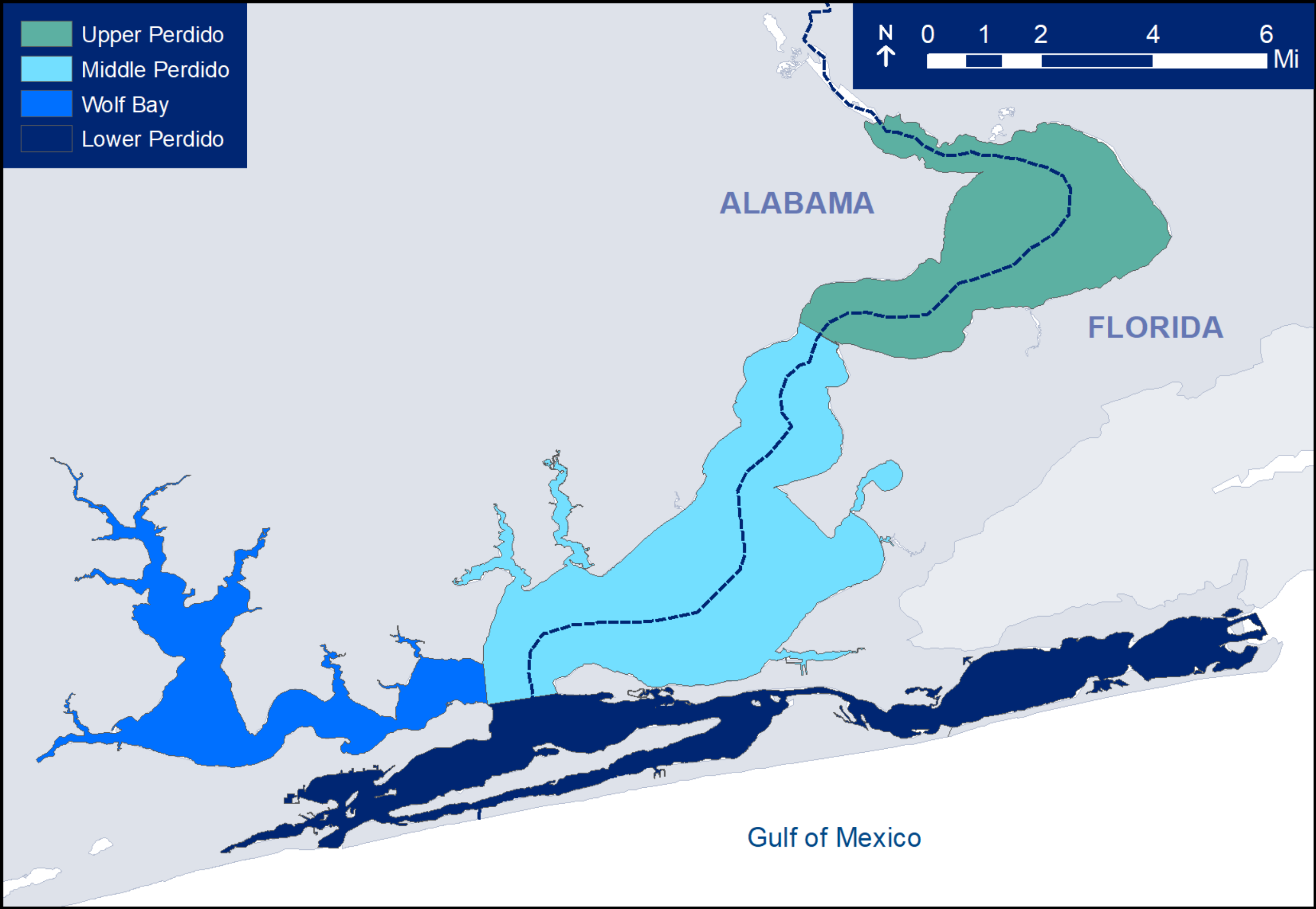

Perdido Bay
Nitrogen

Nitrogen is an essential nutrient for the growth of all organisms in the bay. Excess nitrogen from agricultural and stormwater runoff and wastewater discharges can fuel algal blooms. These blooms can block sunlight from reaching underwater grasses and use up oxygen when they die and decompose. During heavy rain, water washes nitrogen off the land from farmland and hardened surfaces (like paved parking lots) and funnels the excess nitrogen into the bay. We can help reduce the amount of nitrogen in our waterways and improve water quality by protecting our wetlands and forests, which help filter the water.
- Nitrogen concentrations in Perdido Bay have not been consistently monitored
- Sampling frequency and methodology differ among groups that monitor water quality
- Improved coordination among agencies, non-profits, researchers, etc., will be key to evaluate long-term nitrogen trends
How you can help protect water quality
- Practice smart fertilizer use
- Don’t fertilize right before a rainstorm
- Sweep or blow grass clippings and excess fertilizer from driveways and streets back onto the lawn
- Never fertilize within 10 feet of a waterbody
- Learn More!
- Maintain your septic tanks and lateral lines
- Maintain vegetated barriers that act as buffers along wetland edges and streambanks
- Keep shorelines soft and living
- Support water quality monitoring and improvements! Donate here!

Perdido Bay
Phosphorus

Phosphorus is an essential nutrient for the growth of all organisms in the bay. Excess phosphorus from agricultural and stormwater runoff and wastewater discharges can fuel algal blooms. These blooms can block sunlight from reaching underwater grasses and use up oxygen when they die and decompose. During heavy rain, water washes phosphorus off the land from farmland and hardened surfaces (like paved parking lots) and funnels the excess phosphorus into the bay. We can help reduce the amount of phosphorus in our waterways and improve water quality by protecting our wetlands and forests, which help filter the water.
- Phosphorus thresholds vary slightly by bay segment
- Thresholds vary due to different environmental conditions
- Upper and Middle Perdido Bay have remained relatively stable and never exceeded their phosphorus threshold concentrations
- Lower Perdido phosphorus concentrations were more variable over time
How you can help protect water quality
- Practice smart fertilizer use
- Don’t fertilize right before a rainstorm
- Sweep or blow grass clippings and excess fertilizer from driveways and streets back onto the lawn
- Never fertilize within 10 feet of a waterbody
- Learn More!
- Maintain your septic tanks and lateral lines
- Maintain vegetated barriers that act as buffers along wetland edges and streambanks
- Keep shorelines soft and living
- Support water quality monitoring and improvements! Donate here!

Perdido Bay
Chlorophyll-a

Chlorophyll-a is a measure of microscopic algal growth. During heavy rain, water washes nutrients off the land from farmland and hardened surfaces (like paved parking lots) and funnels the excess nutrients into the bay. Excess nutrients from agricultural and stormwater runoff and wastewater discharges can fuel algal blooms. When these algae are in excess during blooms, the water becomes cloudy, starving underwater grasses and animals from the light they need for growth. Once these blooms die, the algal cells decompose, which uses oxygen in the water column and stresses oxygen-dependent life.
- Chlorophyll-a thresholds vary by bay segment
- Thresholds vary due to different environmental conditions
- Chlorophyll-a concentrations in Perdido Bay have not been consistently monitored
- Prior to 2010, chlorophyll-a concentrations frequently exceeded thresholds for most bay segments
- Chlorophyll-a concentrations may be declining, but it is hard to say with certainty due to missing data
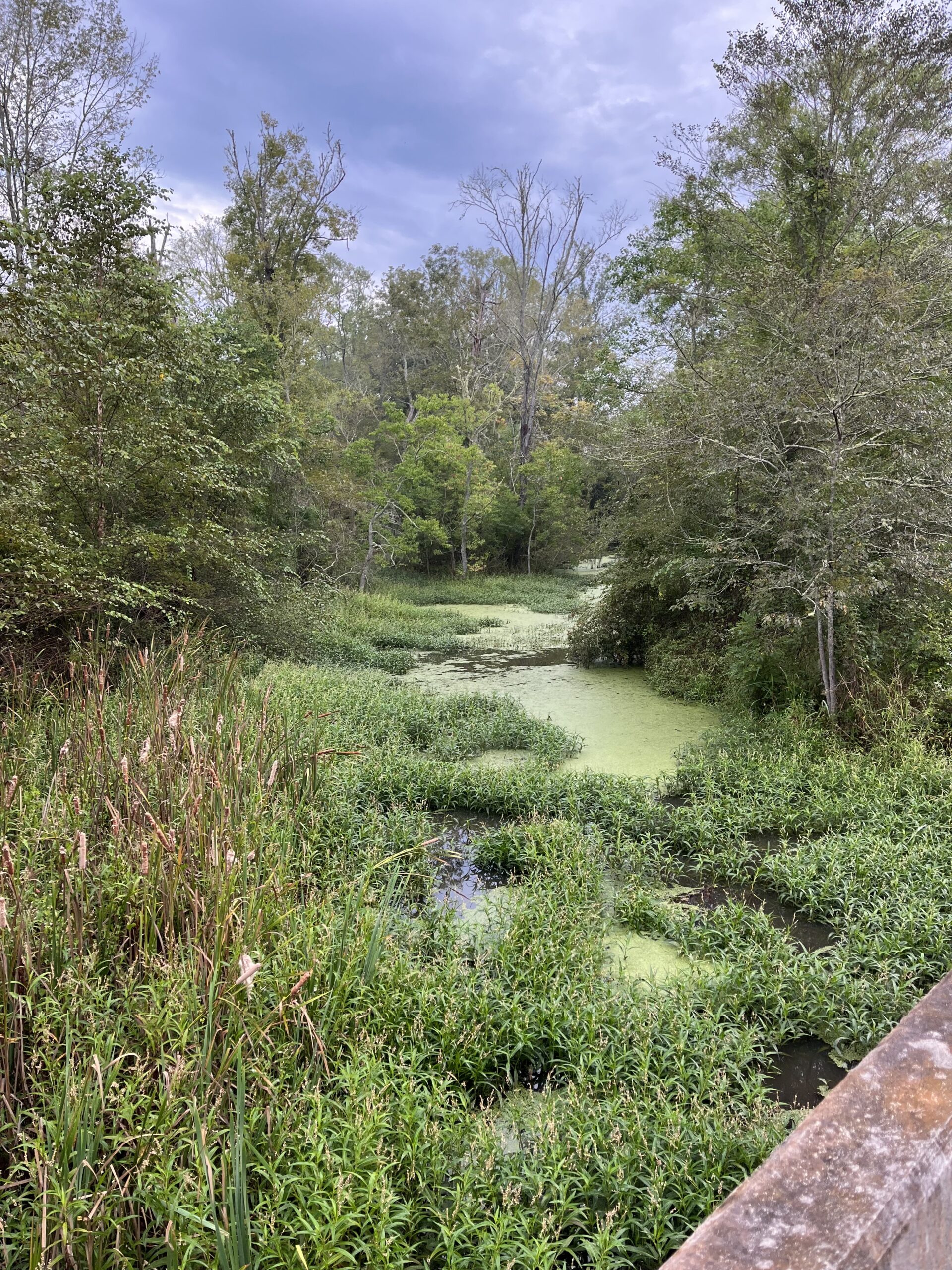
How you can help protect water quality
- Practice smart fertilizer use
- Don’t fertilize right before a rainstorm
- Sweep or blow grass clippings and excess fertilizer from driveways and streets back onto the lawn
- Never fertilize within 10 feet of a waterbody
- Learn More!
- Maintain your septic tanks and lateral lines
- Maintain vegetated barriers that act as buffers along wetland edges and streambanks
- Keep shorelines soft and living
- Support water quality monitoring and improvements! Donate here!


Perdido Bay
Turbidity

Turbidity is a measure of how cloudy the water is and represents particles in the water column. High turbidity can be caused by poor development and construction practices, and runoff from farms, dirt roads, etc. Cloudy water results in shading of light-sensitive plants and animals that need light for growth. A high concentration of particles in the water column can also affect filter feeders, like oysters, and contribute to sediment build up over time, eventually smothering bottom plants and animals.
- Turbidity may be decreasing, but it is hard to say with certainty due to missing data
- No bay segments have exceeded the turbidity concentration threshold

How you can help protect water quality
- Maintain vegetated barriers that act as buffers along wetland edges and streambanks
- Keep shorelines soft and living
- Avoid loose soil on your property. Mulch in gardens can help keep soil in its place.
- Talk to your local elected officials! Well-written land development codes can help reduce the impacts of development
- Support water quality monitoring and improvements! Donate here!

Perdido Bay
Dissolved Oxygen

Oxygen is essential for life within the bay. When large algal blooms die-off, bacteria that decompose the algae consume large amounts of oxygen. Temperature and freshwater discharge are other factors that affect dissolved oxygen levels. During the summer, denser, saltier water sinks to the bottom, while less dense, fresh water stays on top. This layering reduces the mixing between surface and bottom waters, reducing the amount of oxygen in the bottom layer. Warmer water also holds less oxygen, making low dissolved oxygen more common during the summer months.
- Dissolved oxygen concentrations were above 5 mg/L and are increasing in most bay segments
- Wolf Bay is the only bay segment to dip below the dissolved oxygen threshold (once in 2004)
- Many segments, including Wolf Bay have gaps in monitoring, highlighting the need for more consistent monitoring of the region
- Dissolved oxygen shown here represent surface waters due to lack of bottom water monitoring data
- Bottom water dissolved oxygen is more important to sensitive bottom plants and animals. It is important to measure bottom water dissolved oxygen because it does not always match surface levels
How you can help protect water quality
- Practice smart fertilizer use
- Don’t fertilize right before a rainstorm
- Sweep or blow grass clippings and excess fertilizer from driveways and streets back onto the lawn
- Never fertilize within 10 feet of a waterbody
- Learn More!
- Maintain your septic tanks and lateral lines
- Maintain vegetated barriers that act as buffers along wetland edges and streambanks
- Keep shorelines soft and living
- Support water quality monitoring and improvements! Donate here!

